Wood retaining walls offer homeowners an affordable, versatile solution for managing slopes, preventing erosion, and creating functional outdoor spaces. These structures combine practicality with natural beauty, making them ideal for gardens, driveways, and terr aced landscapes. Wood is an attractive and cost-effective option that's easy to work with for DIY projects, though proper construction techniques are essential for longevity. From pressure-treated lumber to naturally resistant cedar and redwood, various wood types provide different benefits for retaining wall construction. Proper drainage, anchoring systems, and regular maintenance ensure these walls remain stable and attractive for decades. Whether you're creating raised garden beds, controlling soil erosion, or adding architectural interest to your landscape, wood retaining walls deliver both functionality and aesthetic appeal.
1. Pressure-Treated Pine Wood Retaining Wall
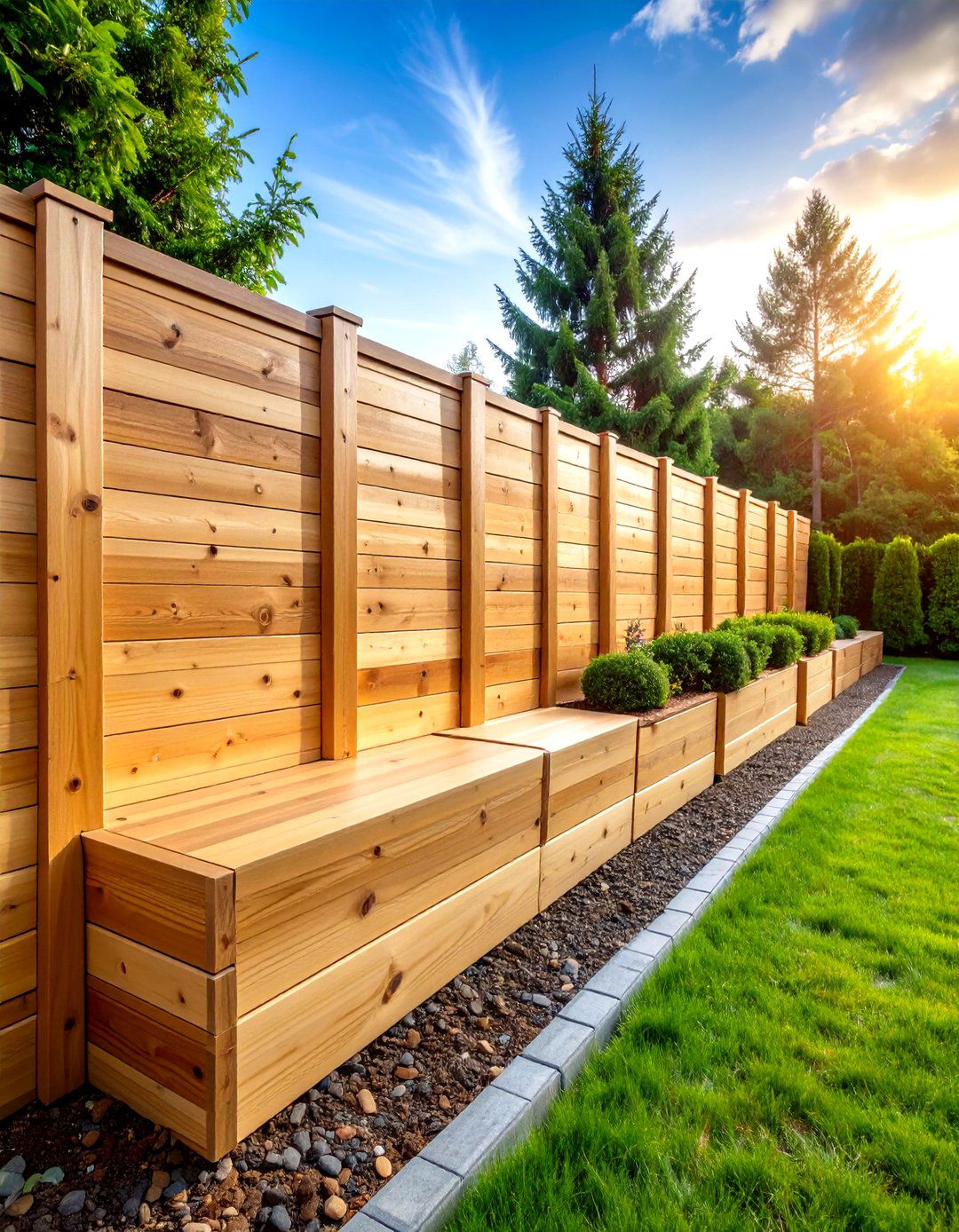
Pressure-treated pine represents the most economical choice for wood retaining walls, rated specifically for ground contact applications. This chemical treatment process infuses the lumber with preservatives that resist decay, insects, and moisture damage for extended periods. These walls typically cost around $15 to $30 per square foot when professionally installed, making them accessible for most budgets. The uniform dimensions and readily available sizes simplify construction planning and material estimation. Modern pressure-treated timber provides excellent durability when properly installed with appropriate drainage systems. However, exposed cut ends require additional preservative treatment to maintain protection, and the lumber should have a rating of.40 or higher for optimal ground contact performance. This option works particularly well for shorter retaining walls under three feet in height.
2. Cedar Wood Retaining Wall for Natural Resistance
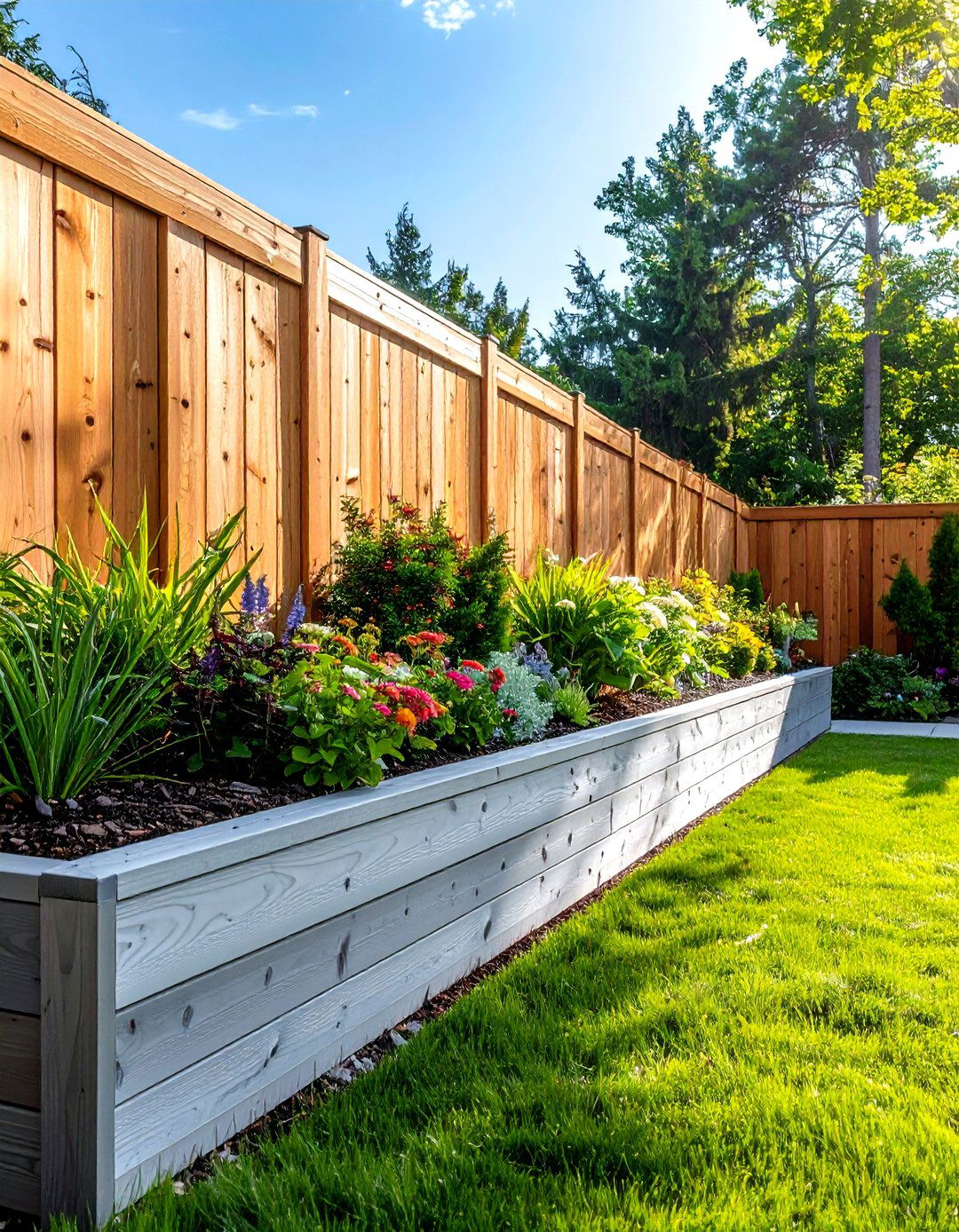
Cedar offers natural resistance to rot and insects through its inherent oils that act as preservatives, extending the wall's lifespan without chemical treatments. Though not as aesthetically striking as redwood, cedar remains an excellent second choice for environmentally conscious homeowners. Western red cedar specifically provides approximately 20 years of service life in ground contact applications. The wood's natural antibacterial and antifungal properties make it particularly suitable for organic gardens and food production areas. Cedar's light weight facilitates easier handling during construction, reducing labor requirements for DIY projects. Foundation-grade cedar, while more expensive than pressure-treated options, represents the preferred material for raised bed food gardens due to health considerations. The silvery-gray weathering pattern develops naturally over time, creating an attractive patina that complements most landscape designs.
3. Redwood Retaining Wall for Premium Durability
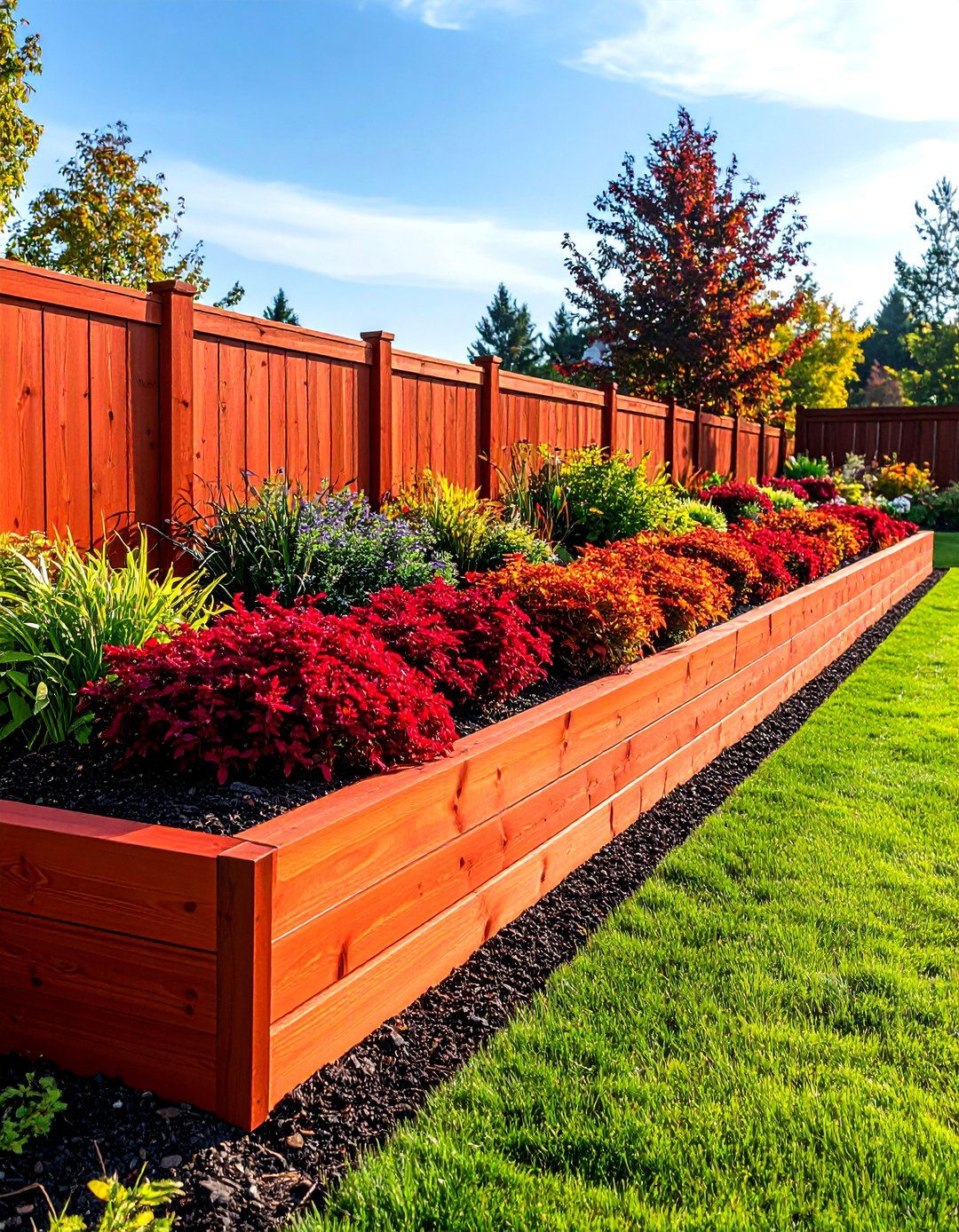
Redwood stands as possibly the best choice for retaining walls, offering exceptional durability and resistance to decay while displaying a distinctive rich, reddish hue. This premium material provides superior longevity compared to other wood options, reducing long-term maintenance costs despite higher initial investment. The natural aesthetic appeal and consistent performance make redwood particularly valuable for high-visibility landscape applications. The wood's natural tannins provide inherent protection against moisture, insects, and decay without requiring chemical treatments. Foundation-grade redwood represents the healthiest choice for organic gardening applications, though it commands premium pricing. Professional installation typically ensures optimal results with redwood, as the material's value justifies expert handling and construction techniques. The rich color deepens with age, creating a stunning focal point that enhances property value.
4. Tiered Wood Retaining Wall System

Tiered retaining walls provide excellent solutions for steep slopes, creating multiple levels of usable space through wooden terraces that transform sloped areas into functional platforms. This design approach distributes soil pressure across multiple smaller walls rather than concentrating forces on a single tall structure. Each tier typically measures 2-4 feet in height, remaining within safe construction limits for DIY installation. These systems help prevent erosion by breaking up water flow and reducing slope velocity. Terraces allow designation of different levels for various functions, such as seating areas, garden beds, or recreational spaces. The natural wood elements add warmth while blending seamlessly with the surrounding environment. Proper spacing between tiers ensures adequate drainage and prevents undermining of upper walls. This configuration works particularly well for gardens, outdoor entertainment areas, and slope stabilization projects.
5. Curved Wood Retaining Wall Design
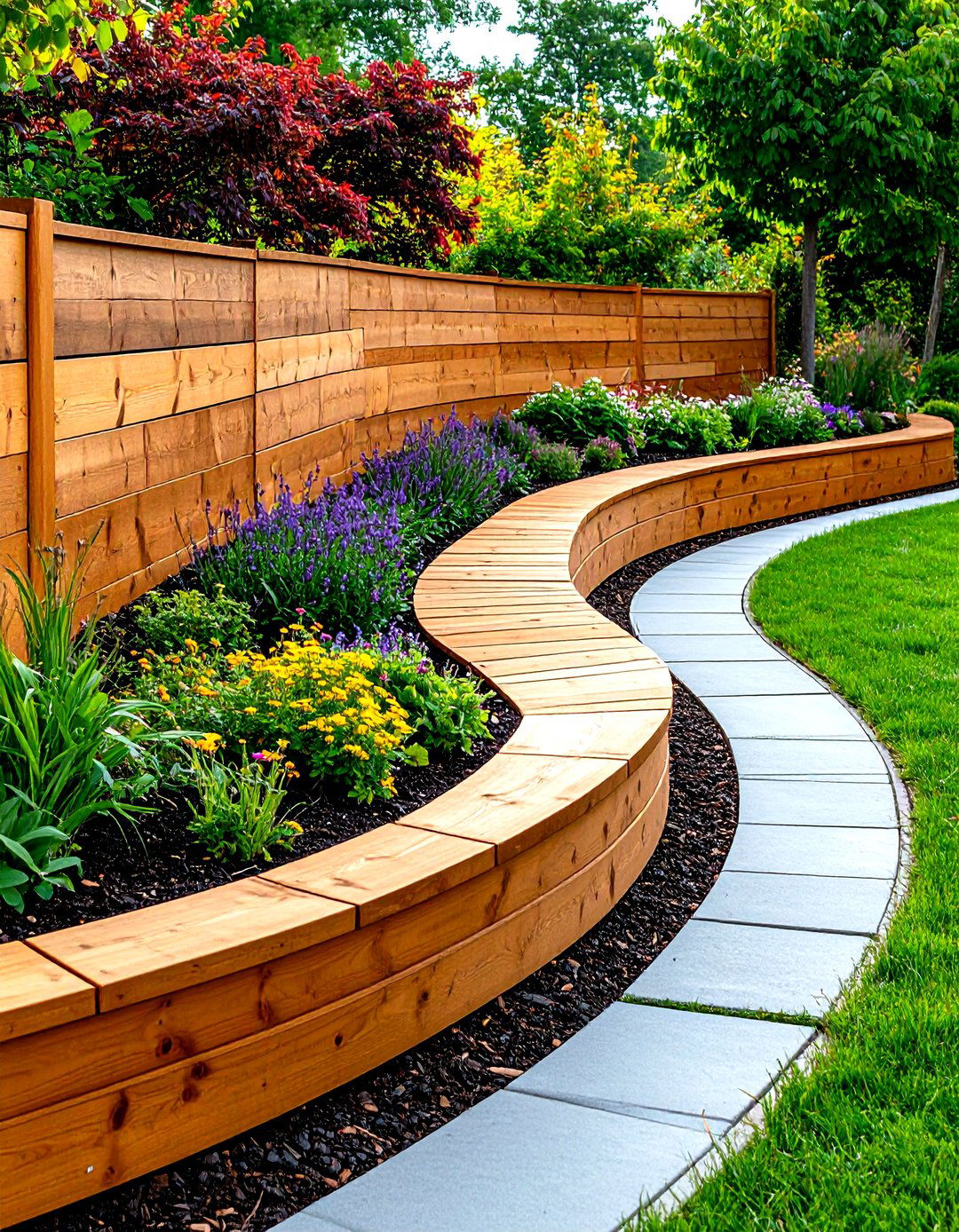
Curved retaining walls break away from traditional straight lines, adding dynamic and fluid elements to landscapes through flexible wooden materials like thin planks or plywood. This design creates smooth, flowing curves that follow natural terrain contours, adding movement and harmony to outdoor spaces. Creative curved applications can deal effectively with sloped areas while providing graceful terraced solutions with easy-to-reach planting spaces. The construction typically requires specialized bending techniques or laminated lumber to achieve desired curves without compromising structural integrity. Steam-bending or kerf-cutting methods allow solid lumber to conform to curved layouts. These designs add visual interest and create focal points that distinguish properties from conventional straight-wall installations. Curved walls work particularly well for garden borders, pond surrounds, and architectural landscape features where artistic expression enhances functionality.
6. Horizontal Timber Wood Retaining Wall
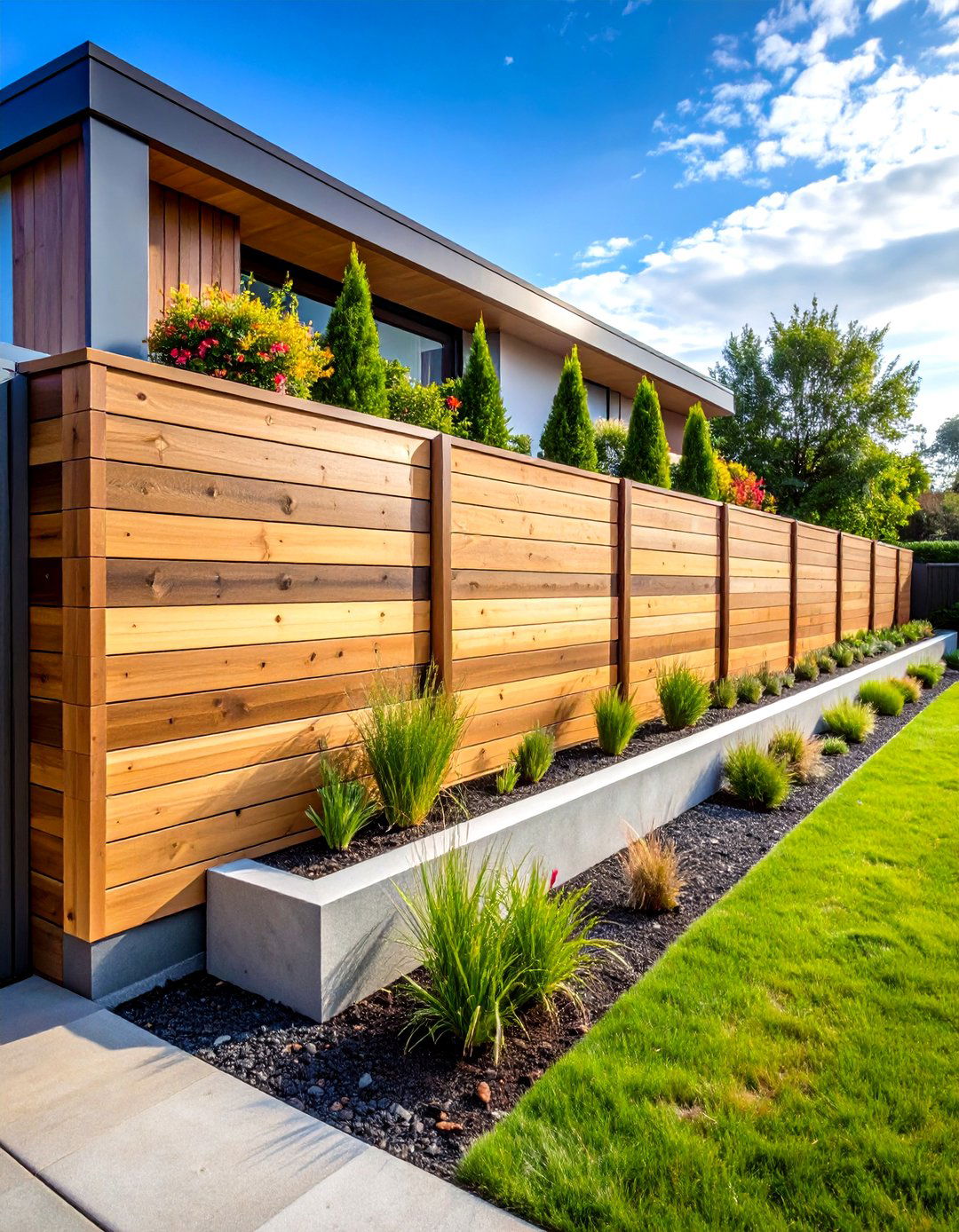
Horizontal timber walls offer sleek, modern aesthetics that work exceptionally well in contemporary landscapes, using wide horizontally laid planks to create visually appealing, streamlined effects. This design maximizes the natural wood grain patterns while providing excellent structural strength for soil retention applications. The horizontal orientation allows for staggered joints between courses, with each row stepping back half an inch from the course below for improved stability. Standard 6x6 or 8x8 timbers work effectively for this construction method, secured with landscape spikes or heavy-duty screws. The clean lines complement modern architecture while maintaining natural warmth and texture. Proper installation includes rebar anchoring through the bottom course and deadman tie-backs on alternating courses for walls over two feet high. This approach creates sophisticated outdoor spaces that balance contemporary design with natural materials.
7. Wood Retaining Wall with Integrated Seating
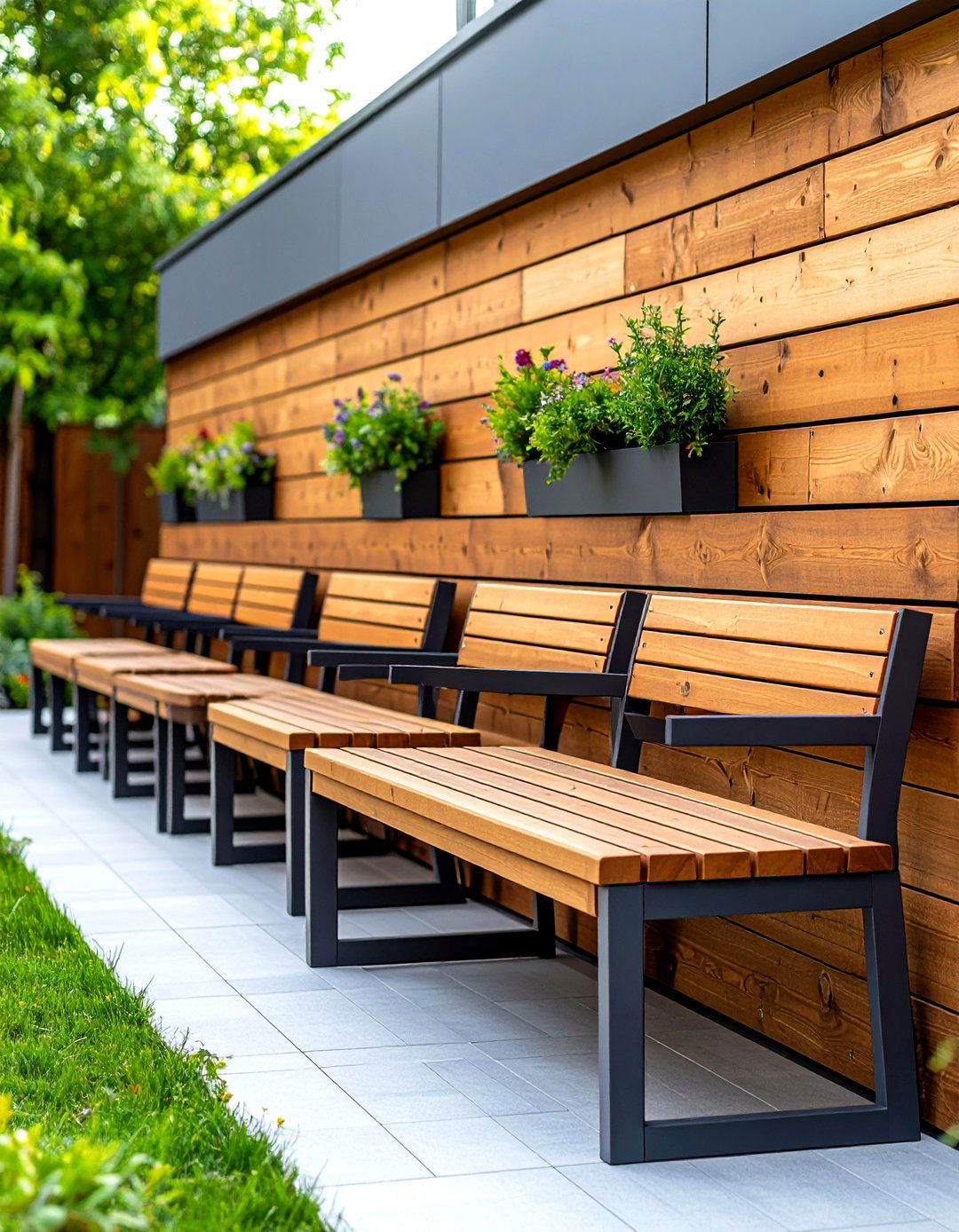
Combining retaining wall functionality with built-in seating creates efficient dual-purpose structures perfect for outdoor entertainment and relaxation. This design features wooden benches built directly into the retaining wall structure, providing sturdy seating while maximizing space utilization. The bench portion typically measures 16-18 inches in height and 14-16 inches in depth for comfortable seating dimensions. This configuration works particularly well for BBQ areas and gathering spaces, offering convenient seating with attractive landscape integration. Modern systems use pressure-treated British wood guaranteed for 15 years, requiring no hidden chemicals while providing safe, sturdy, and durable solutions. Professional designs can incorporate both retaining wall functionality and integrated seating within unified structures. The combination reduces overall construction costs while creating cohesive outdoor living spaces that enhance property functionality and value.
8. Wood Retaining Wall Planter Box Combination
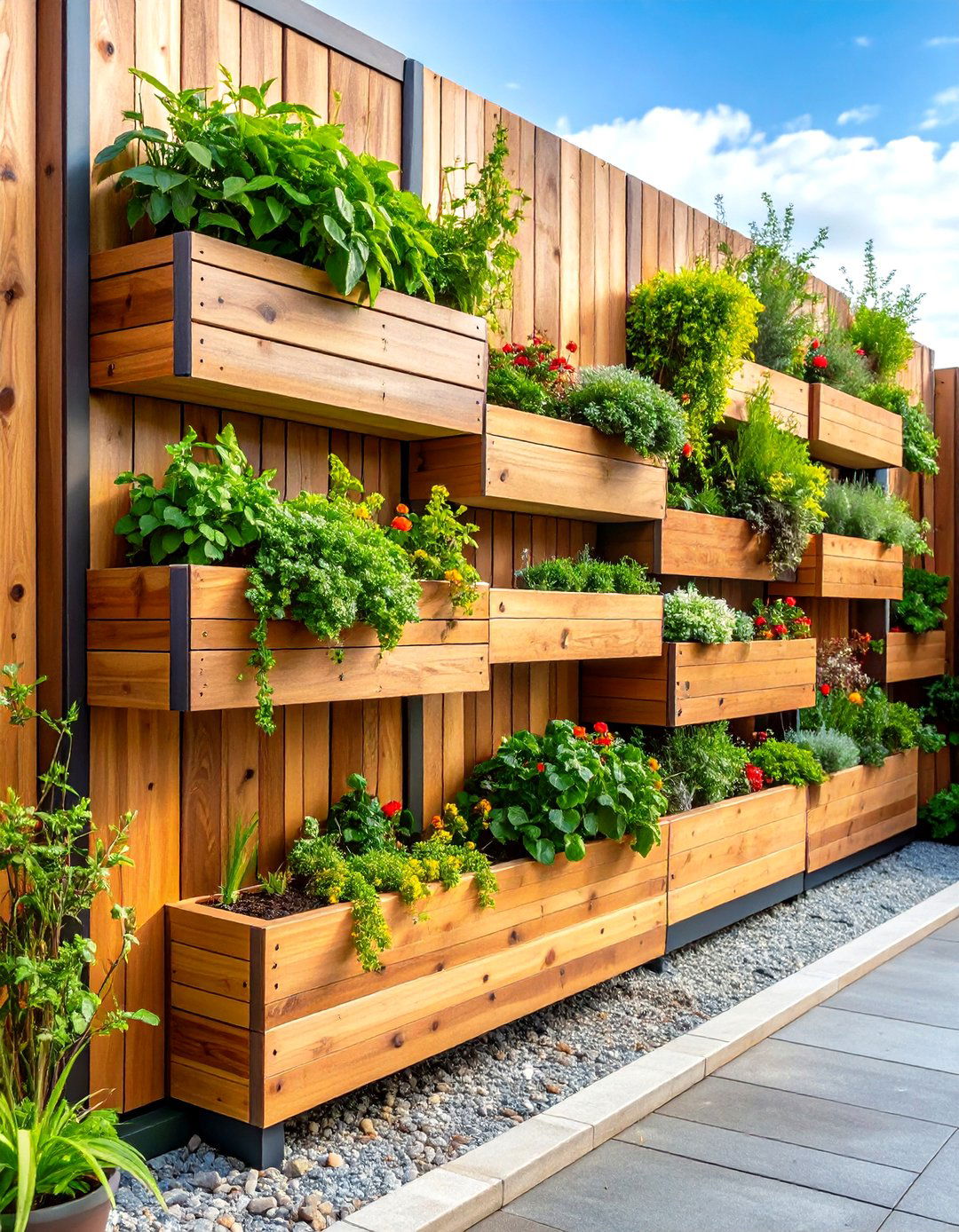
Wooden raised planter retaining walls feature built-in planters at various heights, creating lush green wall effects perfect for vertical gardens and small-space gardening. This design transforms utilitarian retaining walls into living landscape features that support diverse plant communities. The planter boxes replace traditional potted plant arrangements, eliminating the need for continuous pot purchases while providing permanent growing spaces. Built-in irrigation systems can be integrated during construction for automated watering. These structures maximize space efficiency while adding visual interest through layered textures and colors from plant selections. The low retaining wall design around vegetable gardens creates large raised beds that allow better soil control, increased growing capacity, and improved drainage. Fragrant plants like lavender, rosemary, or thyme can enhance sensory experiences, while edible options provide practical gardening benefits.
9. Railroad Tie Wood Retaining Wall

Railroad ties offer an alternative lumber option available at big box retailers and lumber yards, typically providing less expensive solutions than other treated lumber options. However, traditional railroad ties are heavy and soaked with creosote, which can be messy and harmful to plants. Concerns about chemicals leaching into surrounding soil have reduced their frequency in raised bed food gardens. Modern alternatives include precast concrete blocks that resemble timber railroad ties, offering rustic appearance without wood rot risks. When using authentic railroad ties, proper installation includes drilling holes for rebar anchoring and implementing deadman systems for wall stability. The substantial weight of railroad ties provides natural resistance to soil pressure but requires machinery for placement. Many organic gardeners prefer avoiding all wood preservatives, making untreated alternatives more attractive for food production applications.
10. Juniper Wood Retaining Wall for Eco-Friendly Solutions
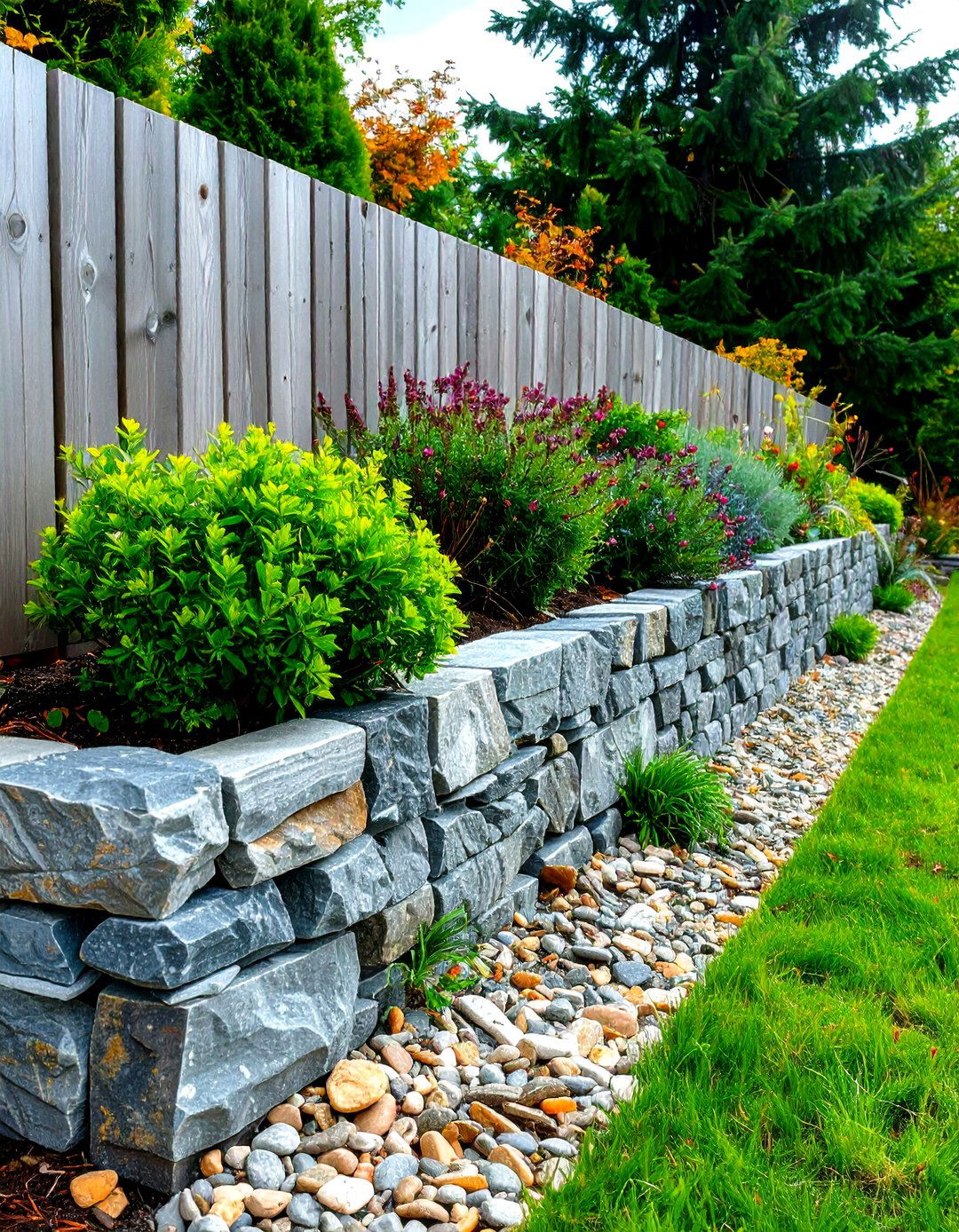
Juniper landscaping timbers provide completely natural, chemical-free alternatives to creosote-laden railroad ties and pressure-treated wood, lasting up to 30+ years in ground contact according to Oregon State University studies. This remarkable durability comes from high concentrations of aromatic compounds that naturally resist microbial decay for decades. Juniper costs significantly less than cedar or redwood while lasting longer than these premium species, providing exceptional value for landscaping budgets. The wood develops a beautiful silver patina over time when left unstained, offering rustic organic appearance perfect for modern garden designs. Purchasing juniper lumber supports collaborative conservation efforts involving ranchers, loggers, environmentalists, and government agencies working to restore grassland ecosystems and water supplies. This environmentally responsible choice combines sustainability with superior performance characteristics.
11. Stepped Wood Retaining Wall with Stairs
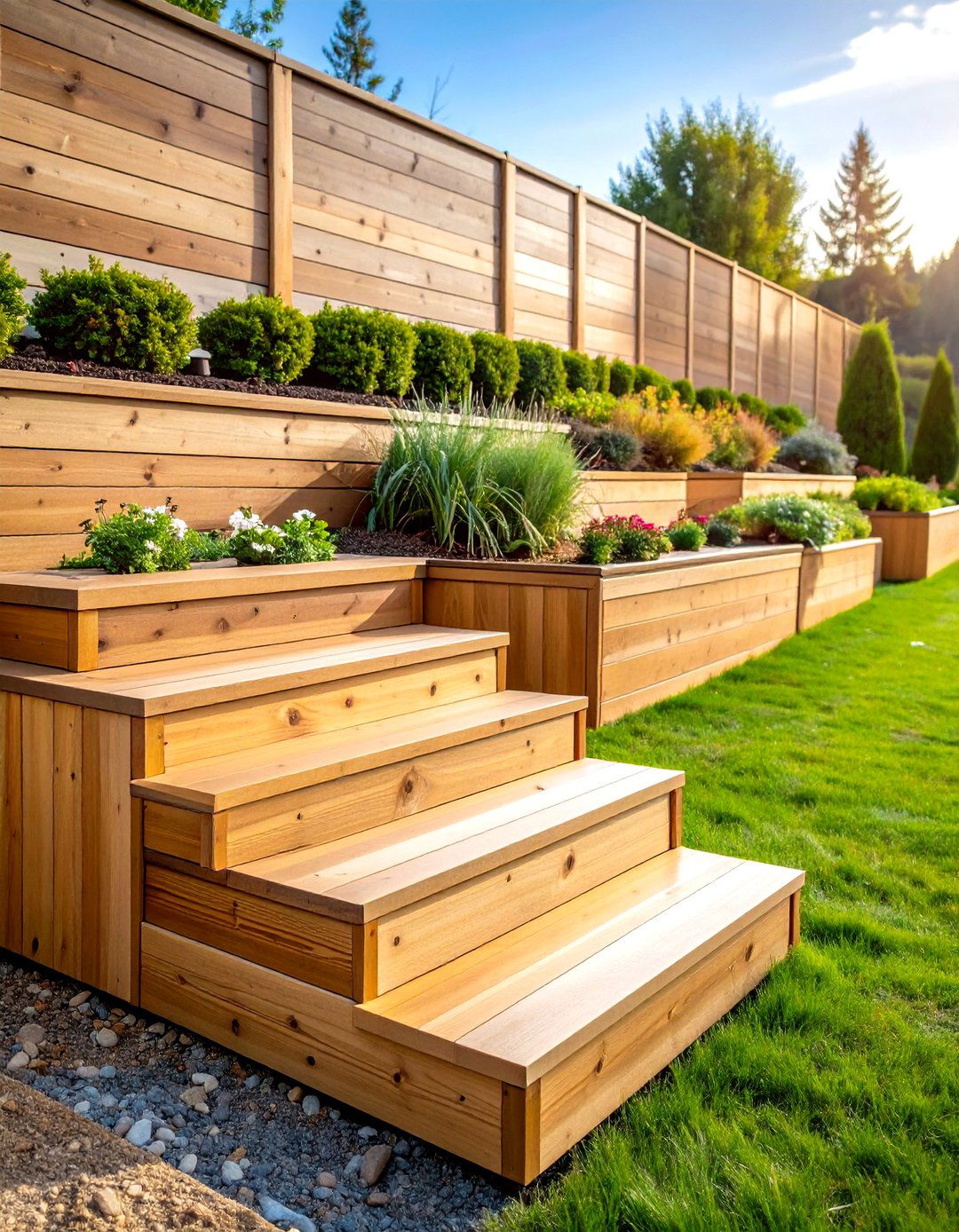
Combining practical access features with retaining wall functionality, stepped designs provide sturdy stairs for entering raised garden tiers while maintaining soil retention capabilities. This dual-purpose approach maximizes construction efficiency by integrating necessary access routes within the wall structure itself. The step dimensions typically follow standard building codes with 7-inch rises and 11-inch treads for safe, comfortable navigation. Integration of retaining walls into stair designs leading to house entrances combines functional and design elements while creating focal points with bright raised flower beds. Built with 5x5 or 6x6 juniper timbers, these installations showcase rich colors and grain patterns while developing attractive patina over time. The construction requires precise measurement and leveling to ensure both structural integrity and safe foot traffic. This design works particularly well for hillside properties where access routes must navigate elevation changes while controlling erosion and creating usable landscape features.
12. Wood Retaining Wall with Deadman Anchors
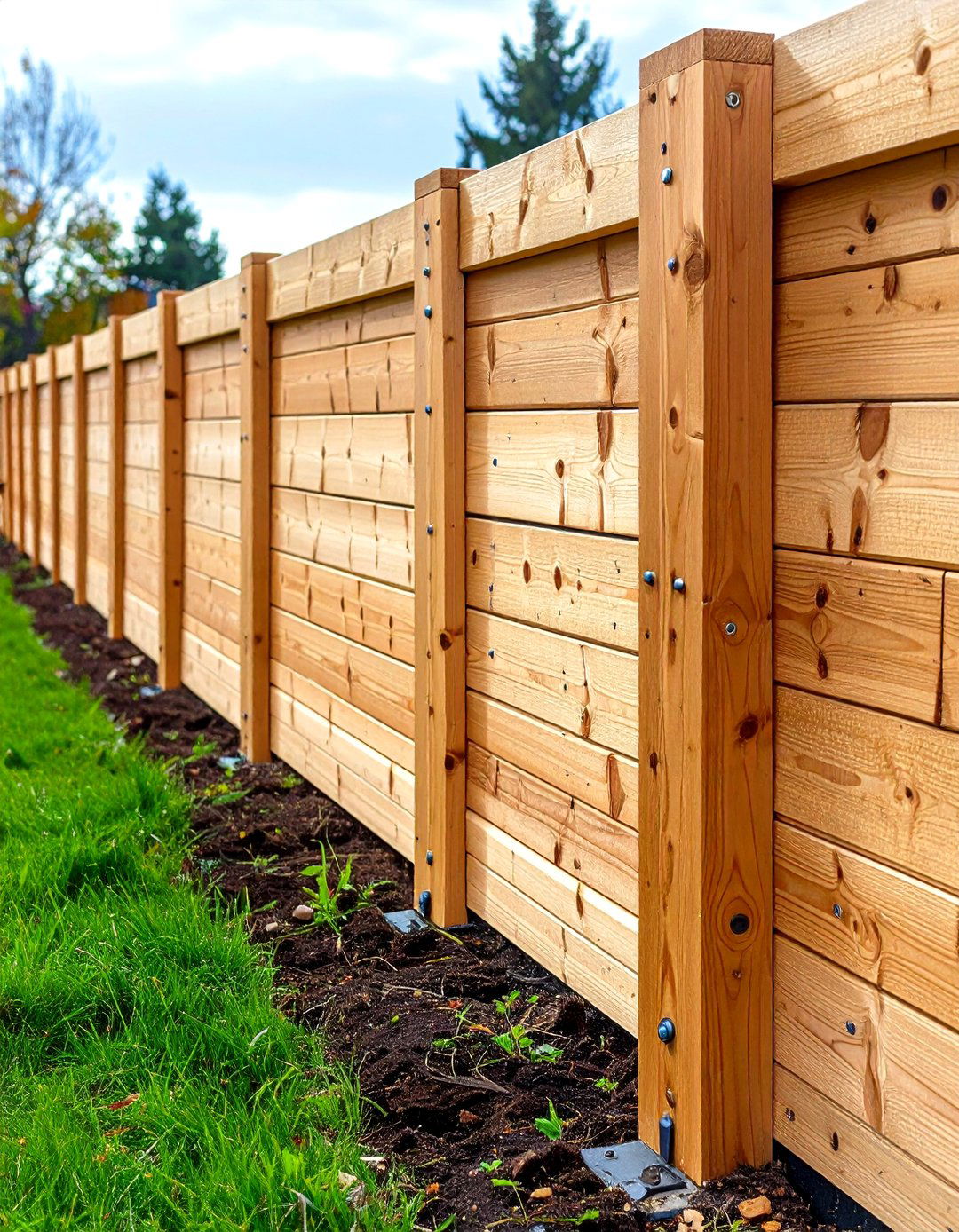
Deadman and tieback systems installed on every other course provide essential anchoring for taller wood retaining walls, with deadmen extending back into stable soil to counteract lateral earth pressure. These buried anchor systems work as counterbalance weights, connecting to walls through tieback members and acting in tandem with drainage systems to enhance stability and durability. Each deadman typically measures 3 feet long, while tiebacks span 4 feet, positioned at 4-foot intervals along wall length. Installation involves digging trenches level with timber courses, placing landscape fabric, and securing connections with 10-inch landscape spikes. Professional designs often specify deadman installation every 8 feet on every other course for 6x6 timber construction. This engineering approach allows construction of walls up to 4 feet high while maintaining structural integrity and long-term stability without requiring professional engineering services.
13. Painted Wood Retaining Wall for Modern Appeal
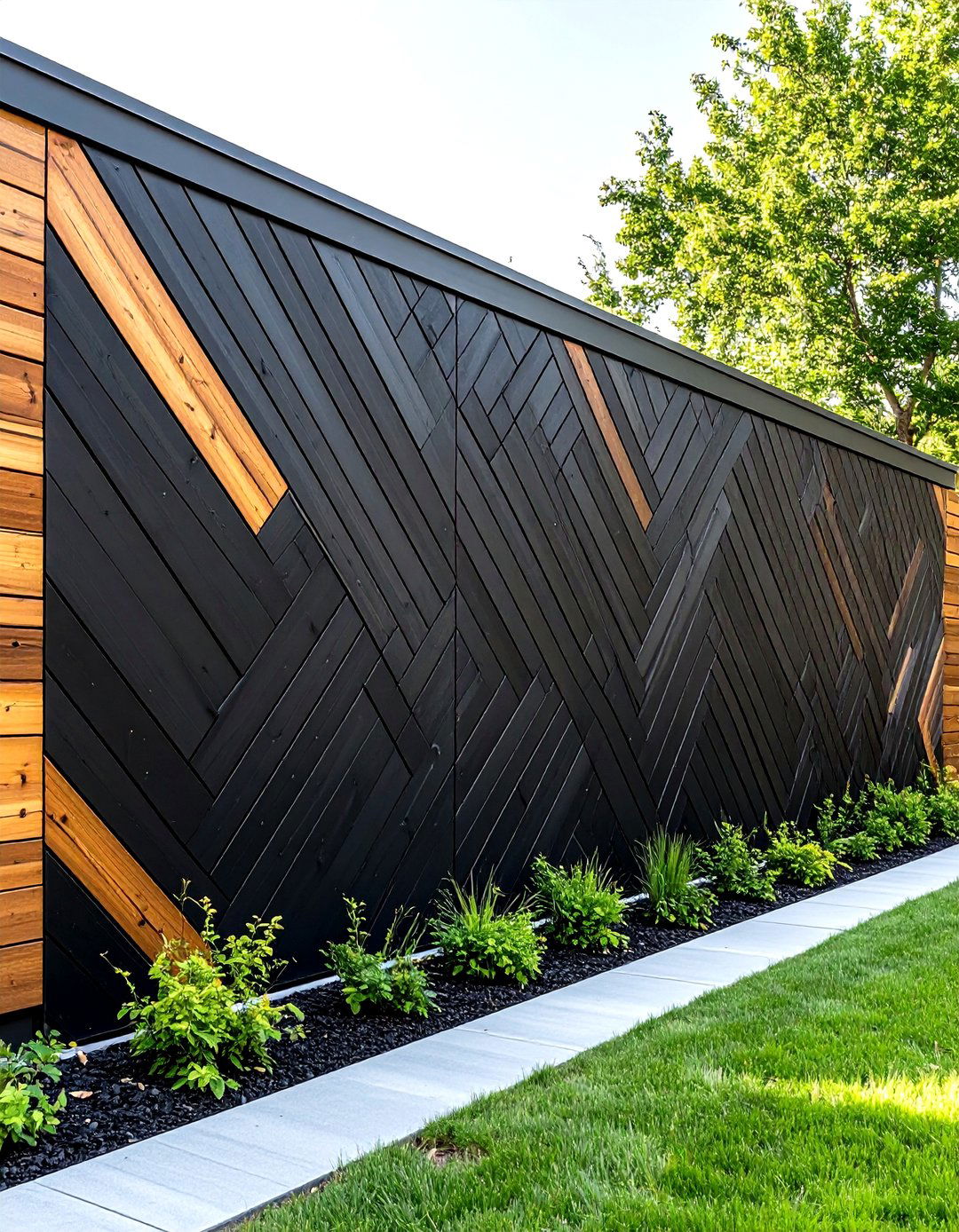
Transforming tired timber walls into modern focal points, painted wood retaining walls utilize exterior paint to create fresh geometric designs and contemporary aesthetics. Black paint applied with painter's tape creates striking geometric patterns that depart from traditional wood appearance while maintaining structural benefits. Color selection should complement existing landscape elements and architectural features for cohesive design integration. The wood can be painted any color preference, aging naturally to soft gray if left untreated, or maintained in chosen colors through periodic repainting. Exterior-grade paints ensure fade resistance and weather protection while allowing creative expression through color and pattern choices. Whether pursuing rustic or modern aesthetics, wood retaining walls can be customized to fit style preferences and budget constraints. This approach revitalizes existing walls or creates bold new landscape statements that distinguish properties through creative design applications while maintaining practical soil retention functions.
14. Wood Retaining Wall with Built-in Lighting
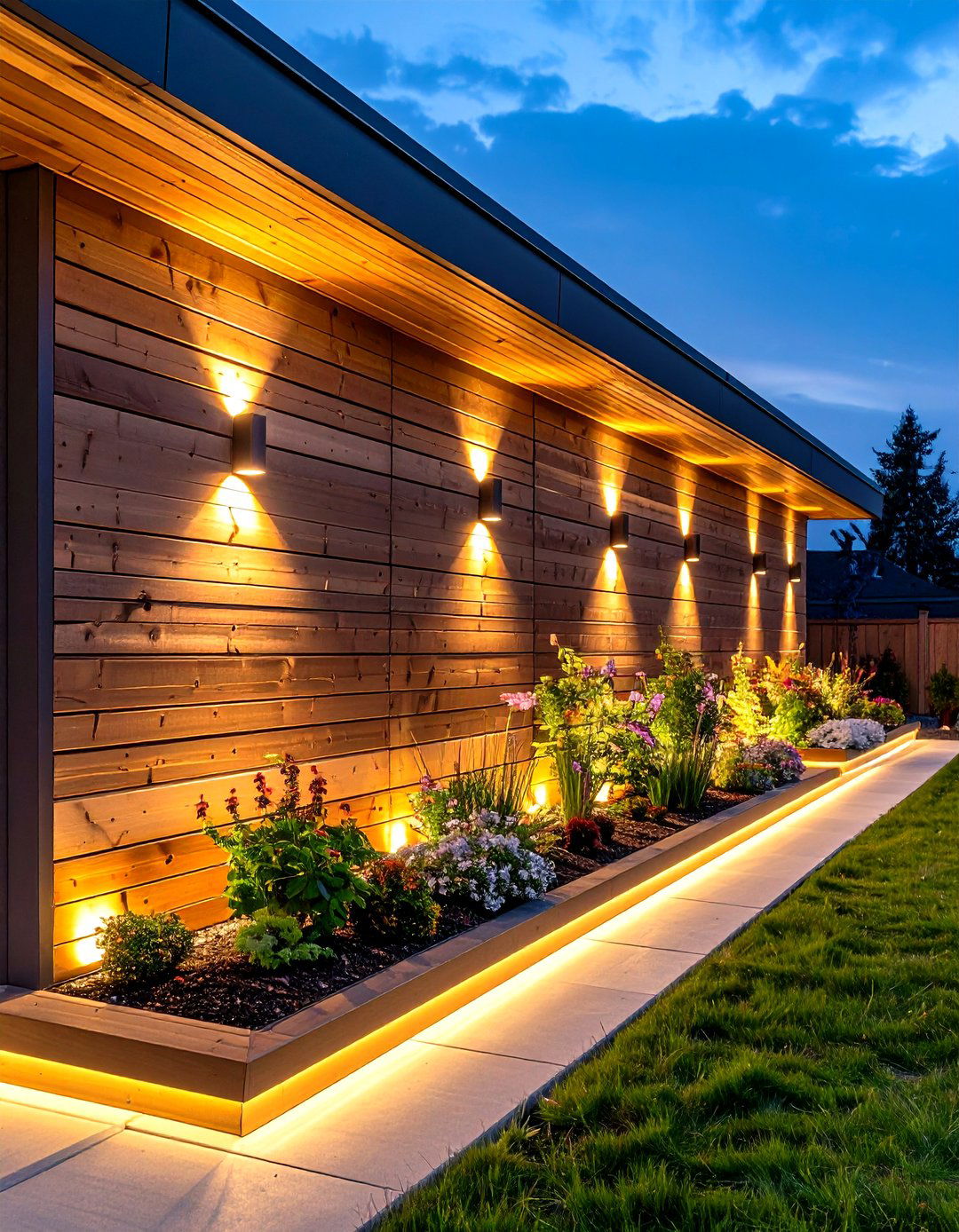
Integrating LED lighting systems into wood retaining wall structures highlights architectural features at night while providing functional illumination for outdoor spaces. Low-voltage LED strips can be recessed into timber faces or mounted along cap boards for dramatic uplighting effects. Integrated lighting displays house numbers on retaining wall faces while providing safety illumination for walkways and entrances. Solar-powered options eliminate electrical wiring requirements while providing eco-friendly operation. The lighting placement should consider both aesthetic goals and practical needs for navigation and security. Modern design approaches use sleek, geometric concrete blocks with integrated LED lighting, though similar effects can be achieved with wooden structures through careful planning. Waterproof connections and proper drainage prevent moisture infiltration that could damage electrical components. This enhancement transforms basic retaining walls into sophisticated landscape features that extend outdoor living hours while improving property safety and curb appeal through professional lighting design.
15. Terraced Garden Wood Retaining Wall
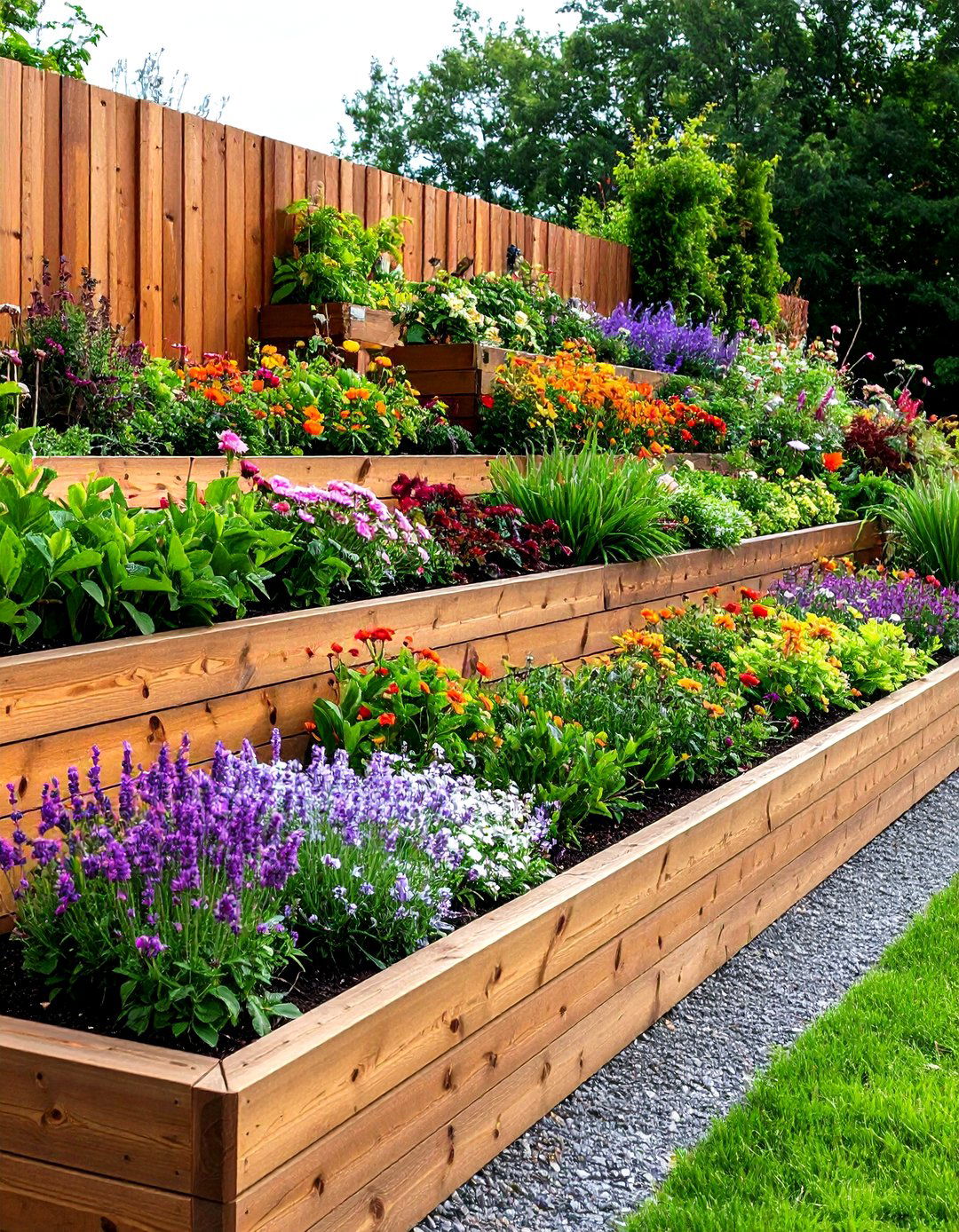
Terraced gardens utilizing multiple wood retaining walls create distinct levels for different functions while adding interest and preventing erosion on sloped properties. Each terrace level can accommodate specific plant communities, seating areas, or garden themes based on sun exposure and drainage characteristics. These installations help turn challenging sloped areas into flourishing gardens planted with colorful flowers while providing structural support through properly designed retaining systems. Terraced walls create graceful transitions on steep slopes while providing easy-to-reach planting spaces for maintenance and harvesting activities. The wood construction allows flexible design that accommodates irregular terrain and creates custom growing environments. Professional installations often incorporate mortared flagstone steps and coordinated materials for unified aesthetic appeal. This approach maximizes usable space on challenging sites while creating dramatic landscape features that increase property value and provide diverse gardening opportunities.
16. Wood Retaining Wall with Stone Accents

Combining wood with stone, concrete, or metal materials creates stunning retaining wall designs that add depth and texture through contrasting materials while maintaining structural integrity. Wood can serve as facing material on concrete walls, or wooden beams can be integrated into stone wall structures for unified appearance. Gabion walls made from steel cages filled with rocks can be enhanced with wooden accents for modern landscape applications. Stone bases provide superior durability and moisture resistance while wooden upper sections offer warmth and visual interest. The material transition requires careful detailing to prevent moisture infiltration and ensure structural continuity. Coordinated stonework between retaining walls and other landscape features like pizza ovens and fire pits creates cohesive outdoor environments. This approach balances natural aesthetics with practical performance while creating distinctive landscape features that reflect sophisticated design sensibilities and long-term durability considerations.
17. Raised Bed Wood Retaining Wall
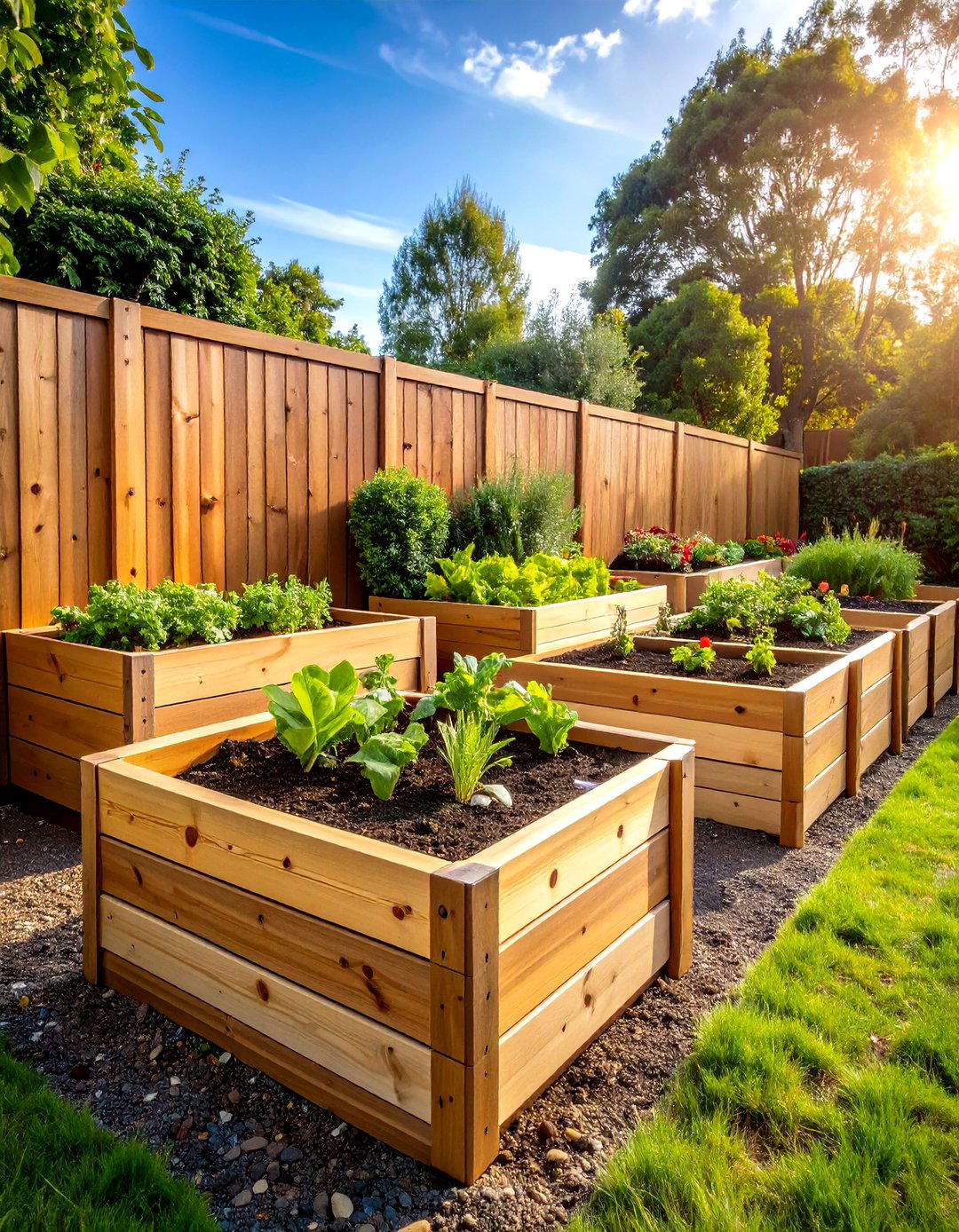
Wood retaining walls designed specifically for raised bed gardens provide elevated growing environments with better soil control, improved drainage, and convenient access for planting and maintenance. Low retaining walls around vegetable garden perimeters create large raised beds that allow greater soil control, increased vegetable production, and enhanced drainage characteristics. The elevated design improves soil warming in spring while providing better pest control and weed management. Foundation-grade redwood or cedar represents preferred materials for food garden applications due to health considerations regarding chemical treatments. Standard heights range from 12-24 inches for comfortable access while providing adequate soil depth for most vegetable crops. Recent demand for raised bed food gardens has brought lighter versions of retaining wall construction into many landscape projects. The contained growing environment allows custom soil mixes while preventing contamination from surrounding areas and creating organized, productive garden spaces.
18. Wood Retaining Wall with Gabion Combination
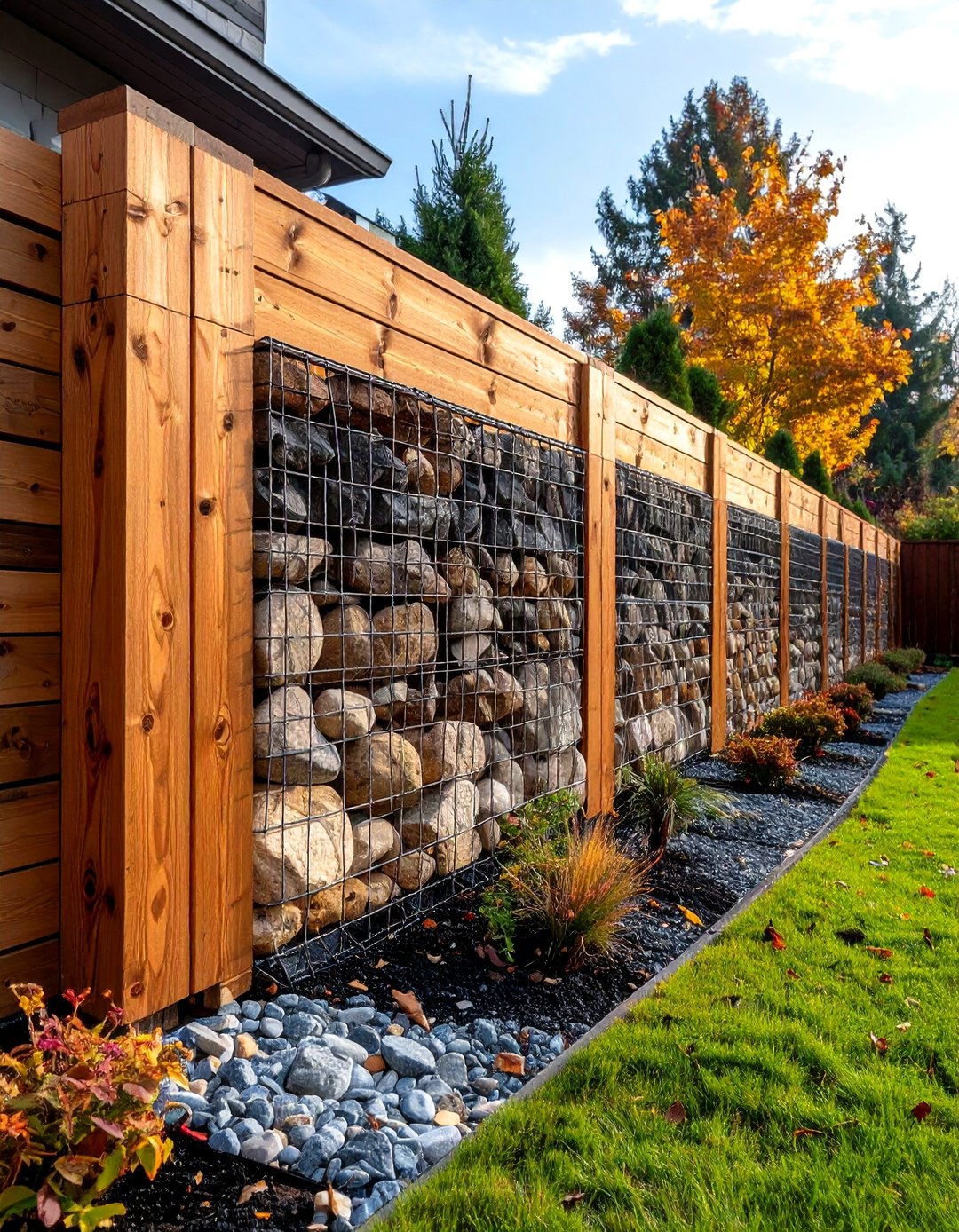
Gabion walls constructed from wire mesh baskets filled with rocks offer modern alternatives that can be enhanced with wooden accents for contemporary landscape applications. These wire cage systems provide strength and durability while offering high permeability for drainage applications. The rustic, natural appearance blends well with outdoor environments while providing quick installation for erosion control projects. Wooden caps, faces, or frame elements can soften the industrial appearance while adding warmth and visual interest to gabion installations. Gabion walls typically require professional installation to ensure suitable rock selection and proper stability. The combination approach utilizes the drainage benefits and strength of gabion systems while incorporating wood elements for aesthetic enhancement. This hybrid design works particularly well for modern landscapes that require both functionality and sophisticated appearance. The low maintenance requirements and exceptional drainage characteristics make this combination ideal for challenging site conditions.
19. Vertical Board Wood Retaining Wall
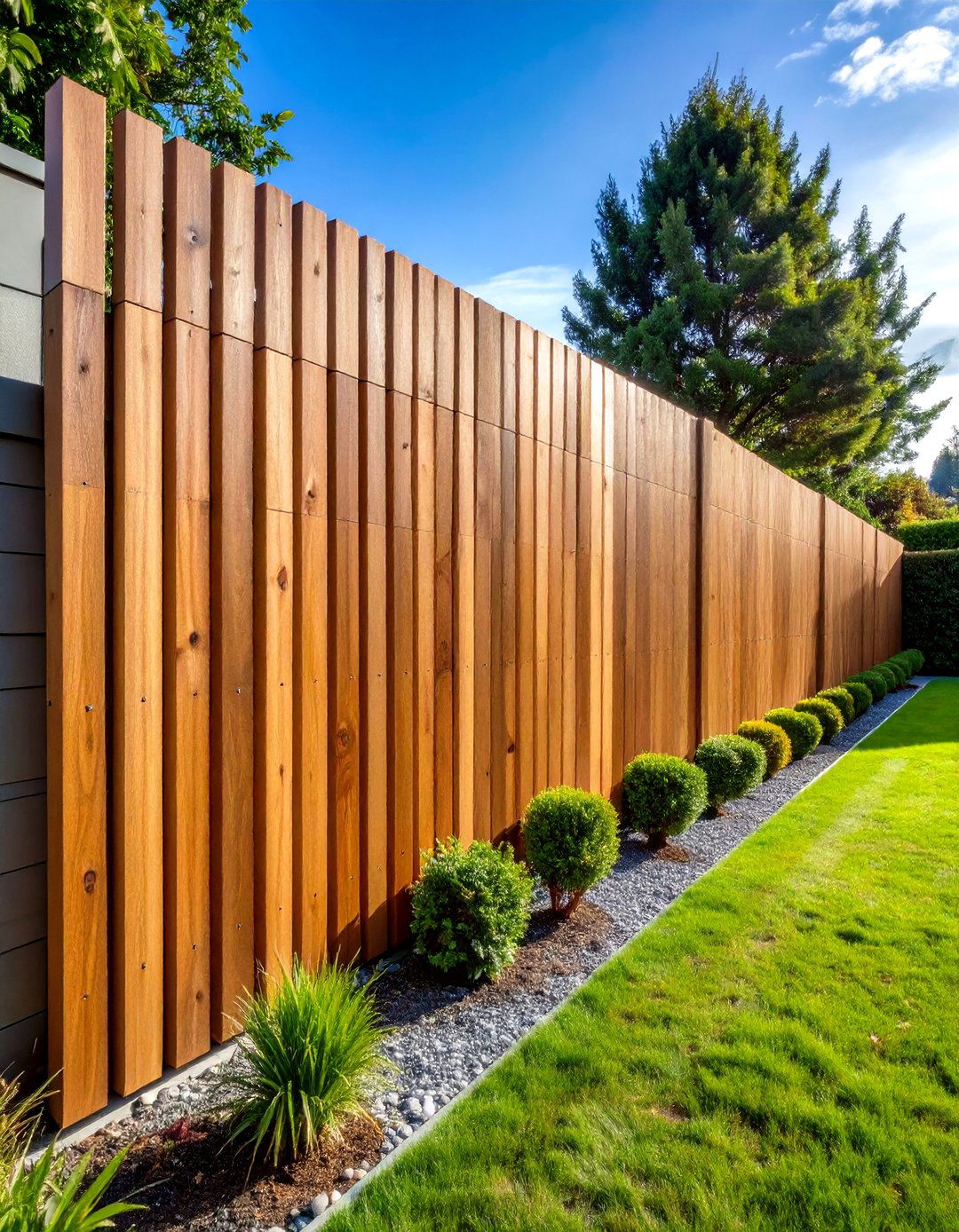
Unlike horizontal timber construction, vertical board installations create contemporary fence-like appearances while providing effective soil retention for modern landscape designs. This orientation emphasizes height rather than mass, creating sleek profiles that complement contemporary architecture. The vertical boards typically measure 1x6 or 2x6 inches, attached to horizontal backing members or posts for structural support. Vertical installations can be positioned on both soft and hard surfaces, including grass, bare earth, paving, and concrete applications. The design allows creative spacing patterns, alternating widths, or mixed material combinations for custom aesthetic effects. Proper foundation and drainage remain essential for vertical installations, though the construction methods differ from traditional horizontal approaches. The wood naturally ages to soft gray coloring, or can be painted any desired color for specific design requirements. This approach creates sophisticated urban landscape features while maintaining natural material benefits and cost-effectiveness.
20. Wood Retaining Wall with Water Feature Integration
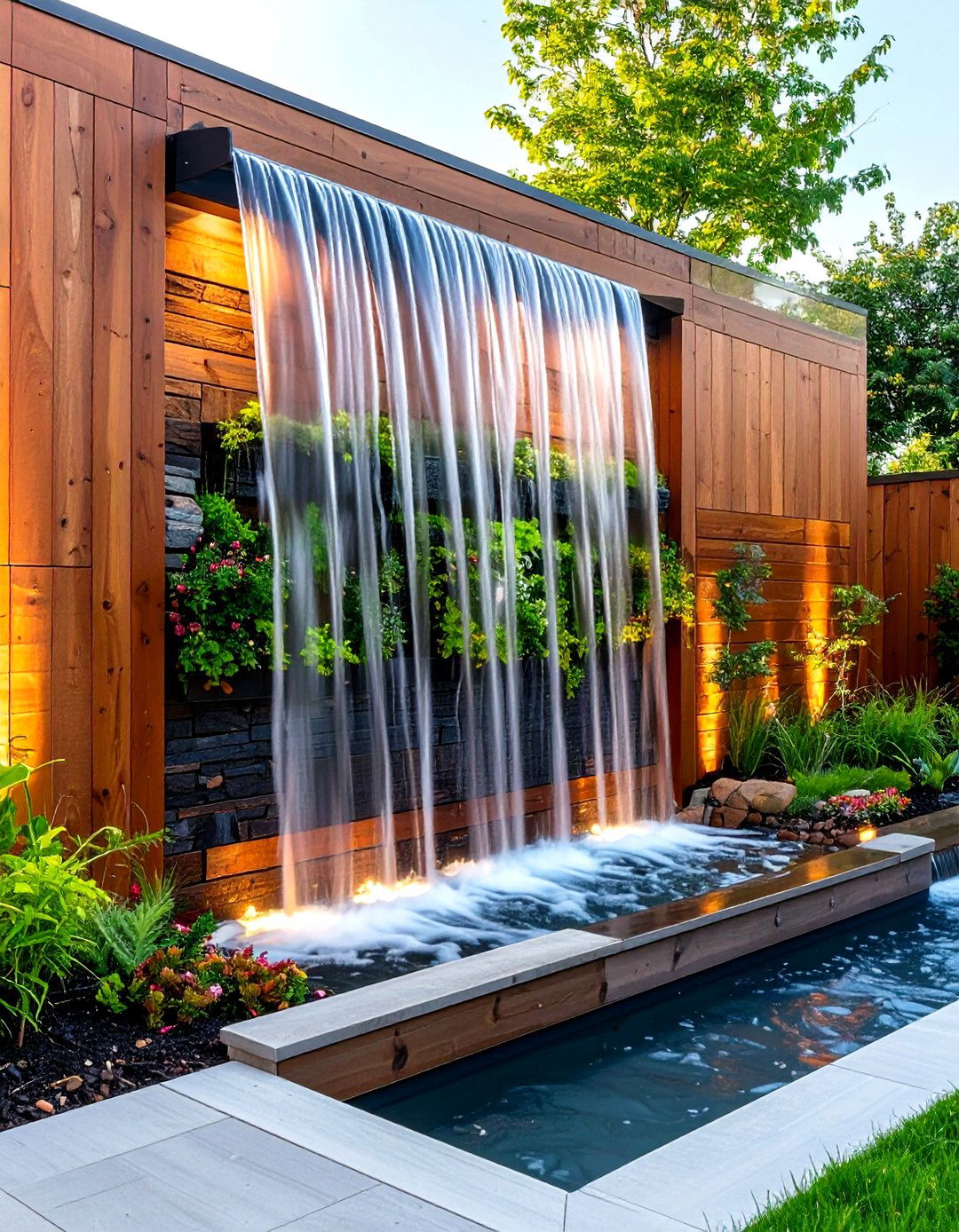
Integrating water features like cascading waterfalls and ponds directly into wood retaining wall designs creates stunning landscape focal points that combine soil retention with ornamental elements. Professional installations typically coordinate stone materials between retaining walls and water features for cohesive visual appeal. The water elements provide soothing sounds while creating dynamic visual interest that transforms utilitarian walls into destination features. Contemporary designs can incorporate running water features within paver retaining walls for sophisticated outdoor environments. Proper waterproofing and drainage design prevent structural damage while ensuring water circulation systems function effectively. The wooden elements provide natural warmth that contrasts beautifully with water features while creating habitat for beneficial wildlife. These elaborate installations usually require professional help to ensure proper integration and long-term functionality. The combination creates premium landscape features that significantly enhance property value while providing year-round visual interest and relaxation benefits for outdoor living spaces.
Conclusion:
Wood retaining walls offer exceptional versatility, combining affordability with natural beauty to solve diverse landscape challenges. From basic pressure-treated installations to sophisticated designs featuring integrated seating, planters, and water elements, these structures adapt to virtually any outdoor environment. Proper drainage installation and regular maintenance ensure long-term performance while preventing costly structural failures. Whether creating terraced gardens, controlling erosion, or enhancing outdoor living spaces, wood retaining walls deliver both functionality and aesthetic appeal. The variety of wood species, construction methods, and design options allows customization for specific needs, budgets, and architectural styles, making them ideal solutions for transforming challenging slopes into beautiful, usable landscape features.


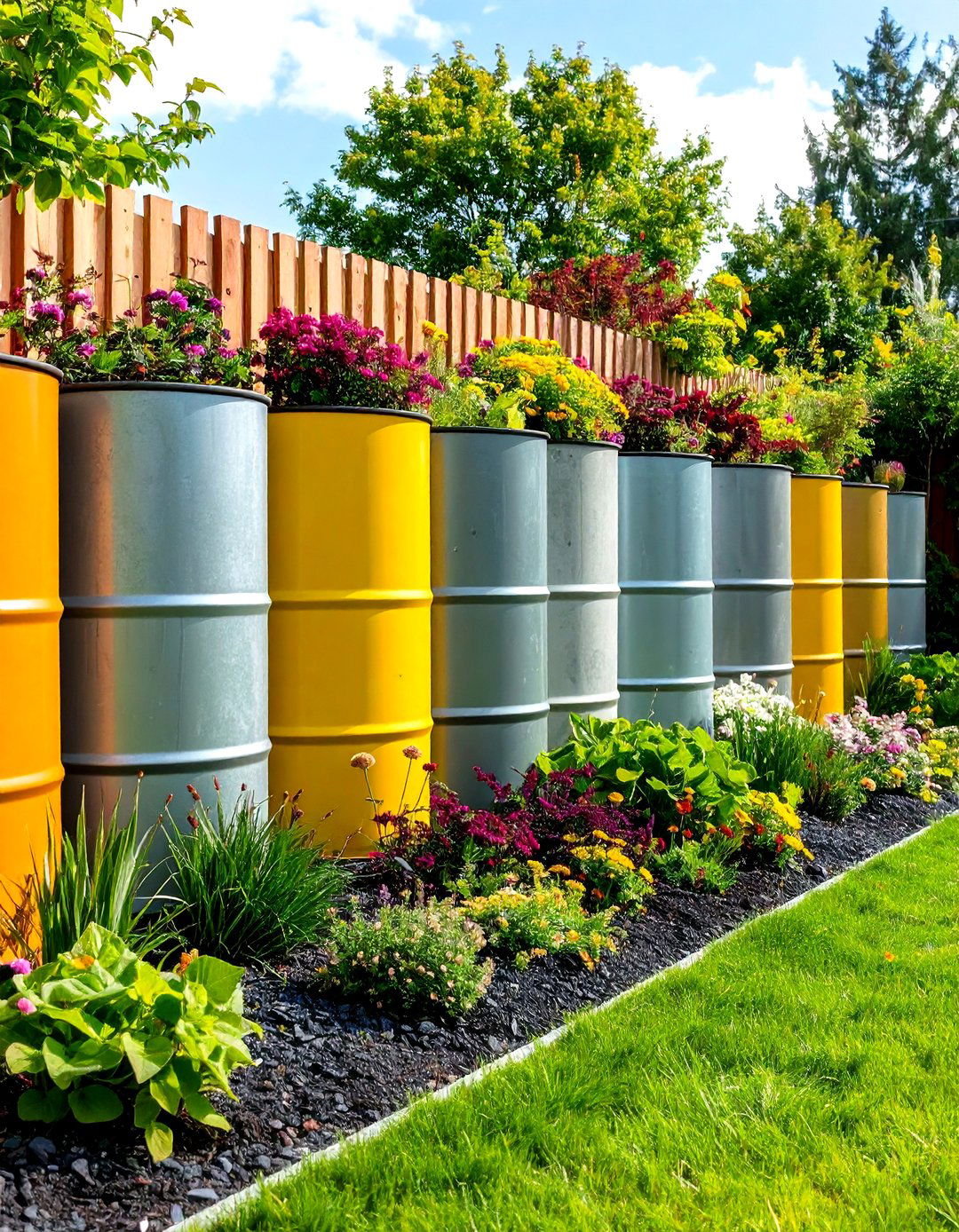
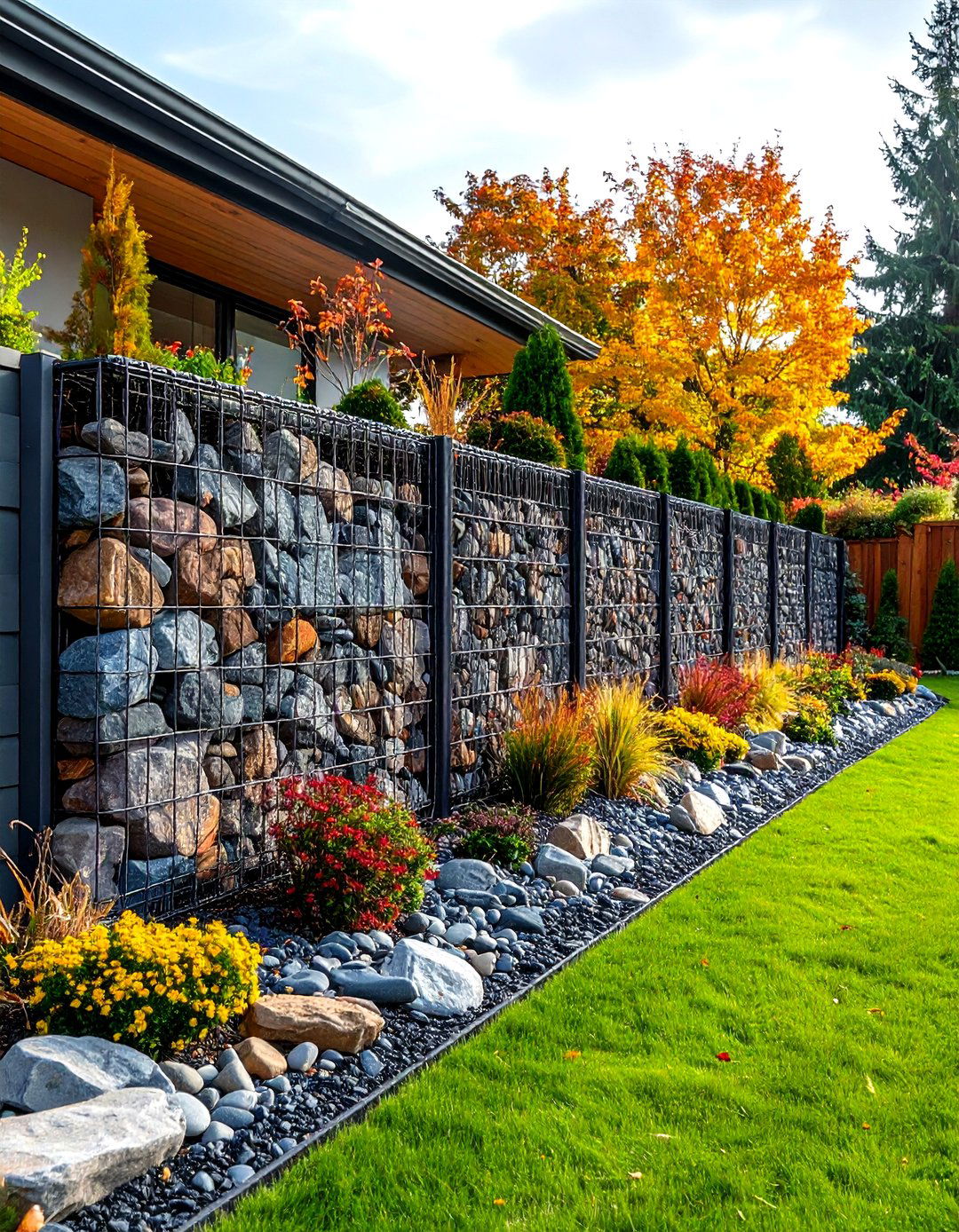
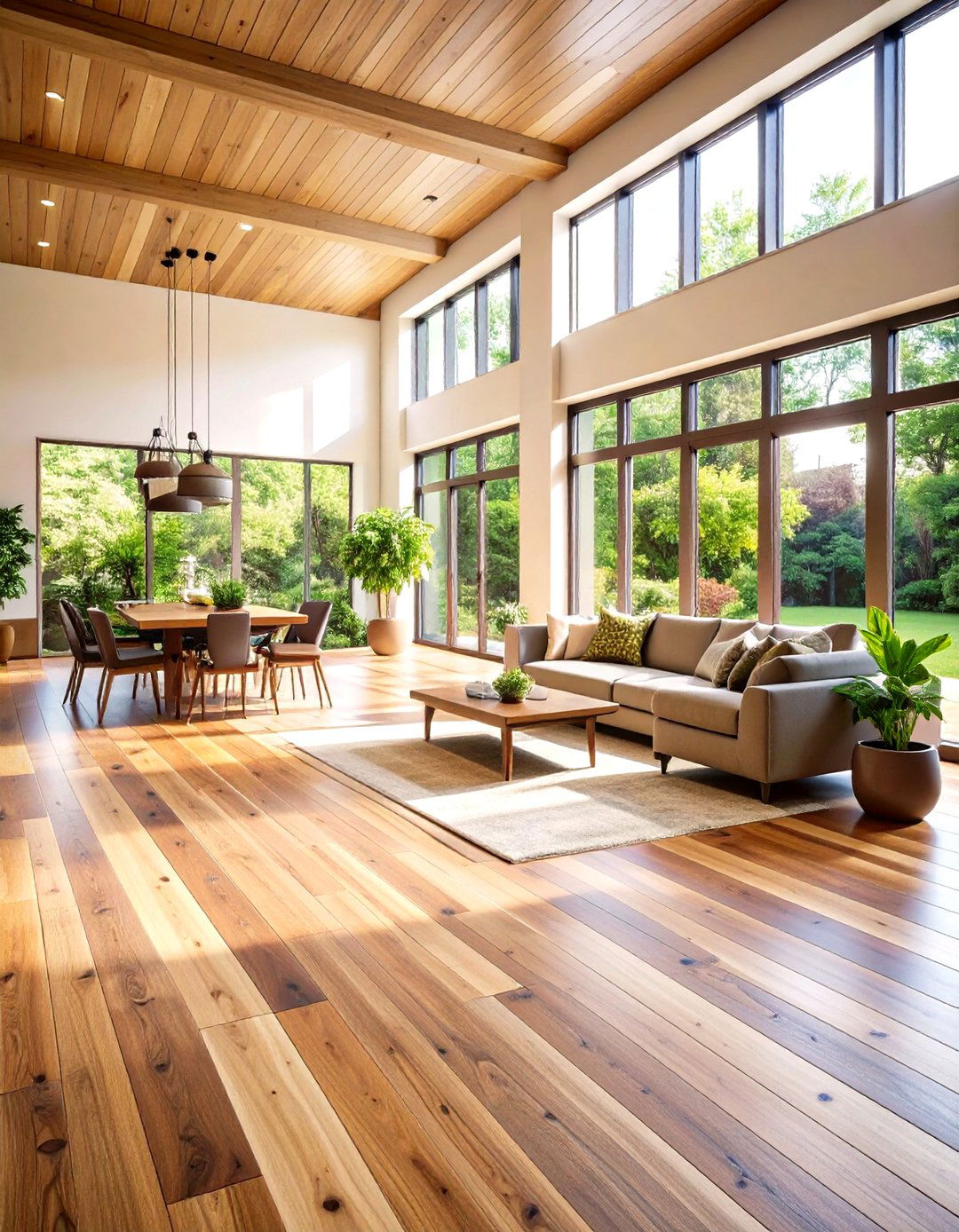
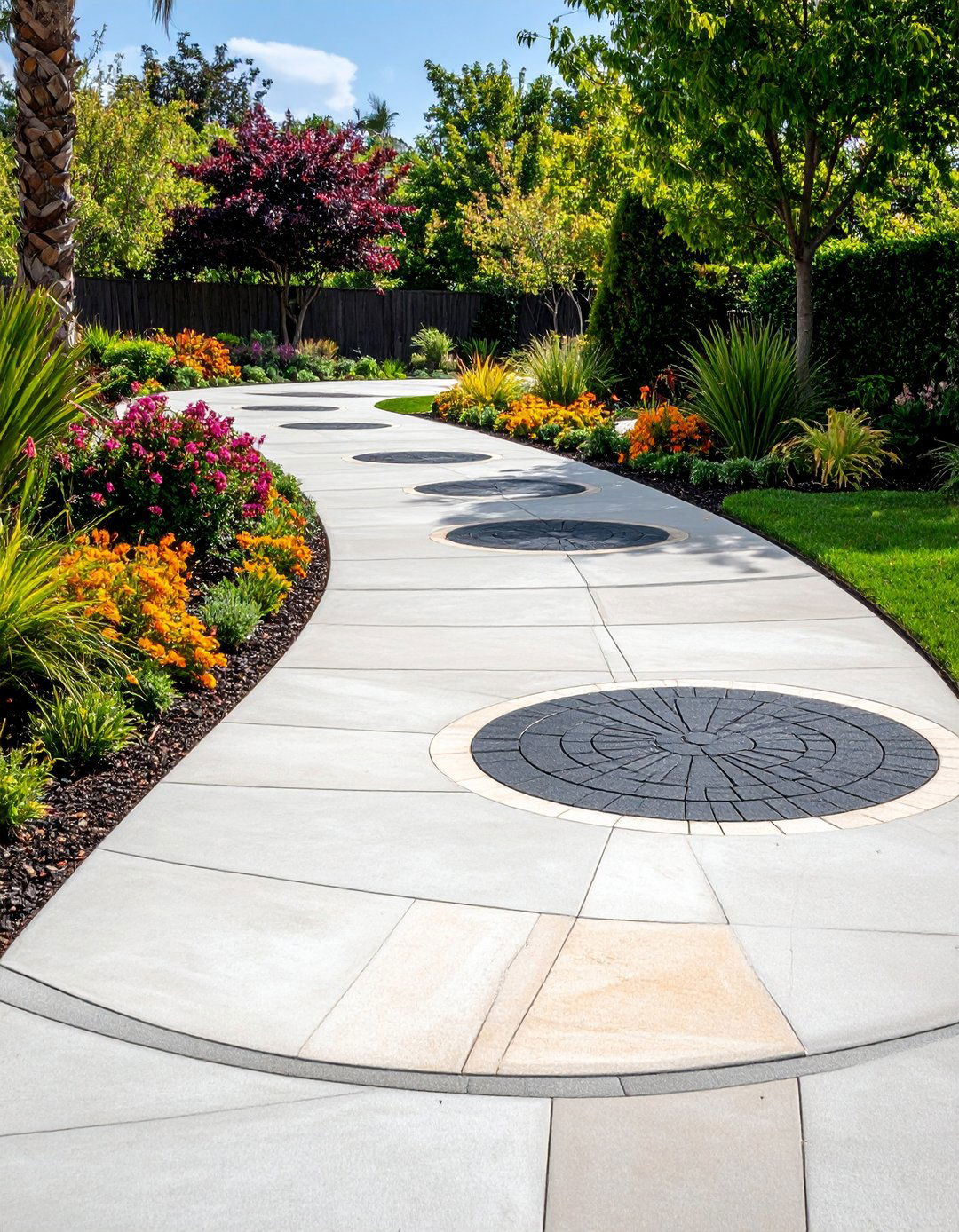
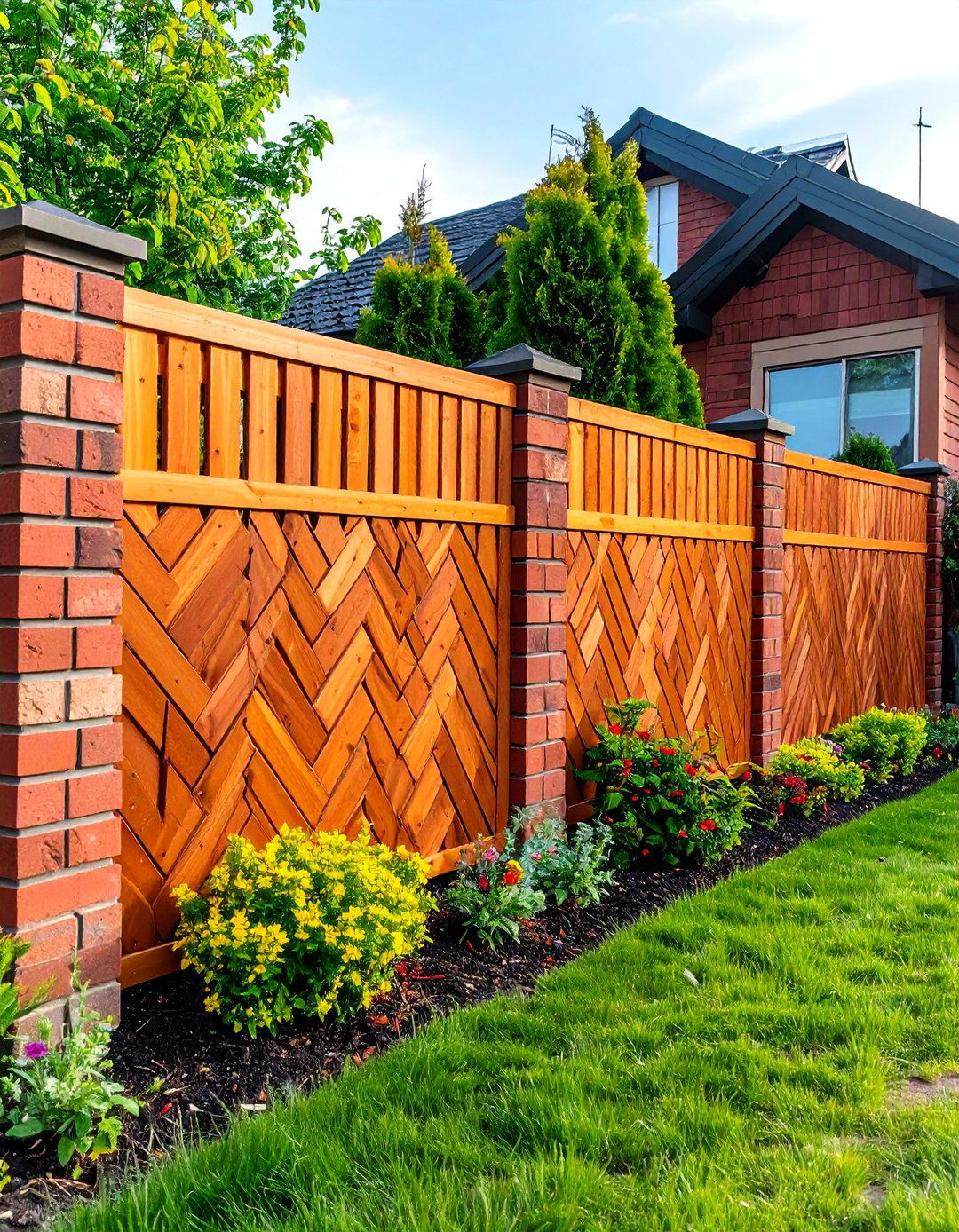
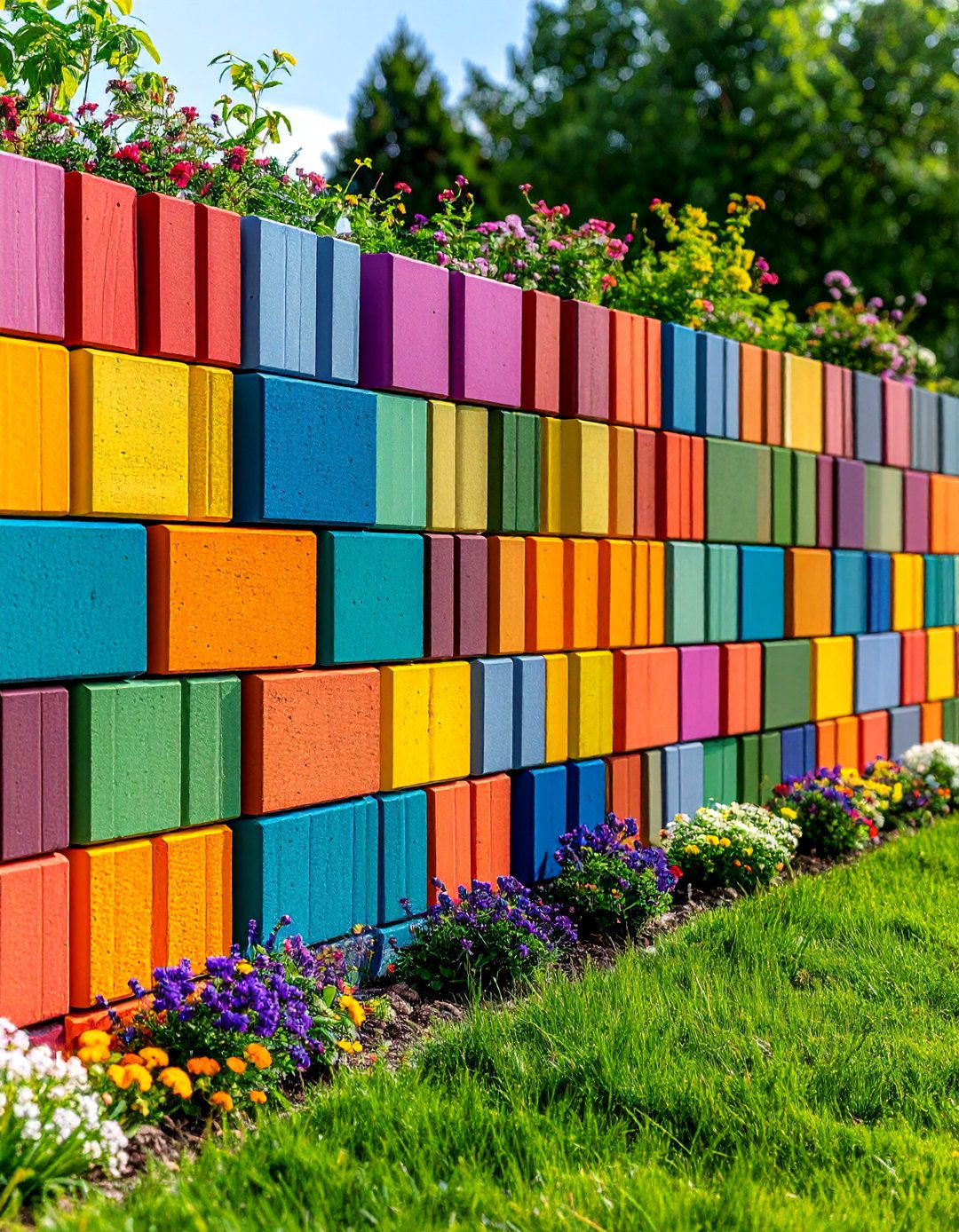
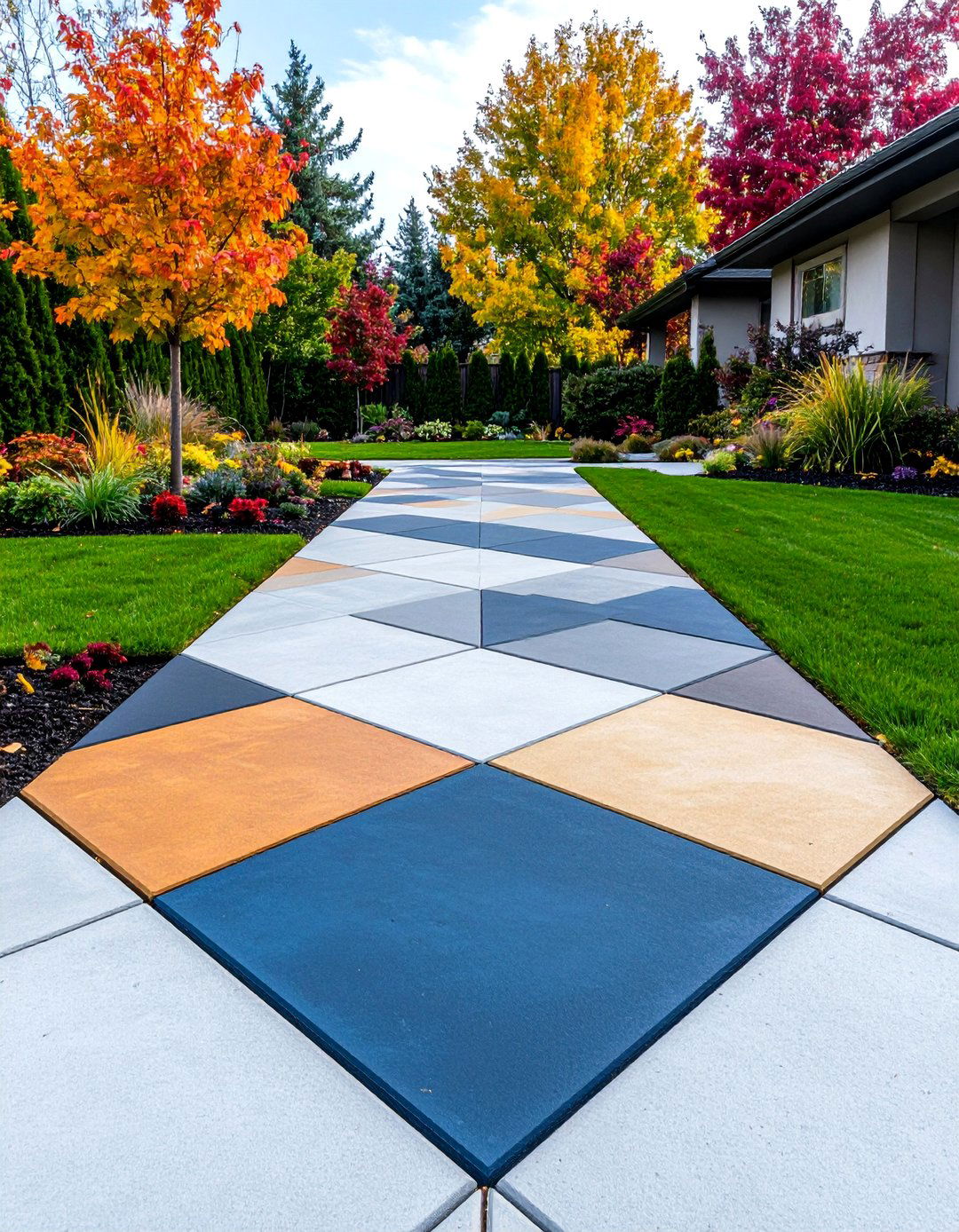
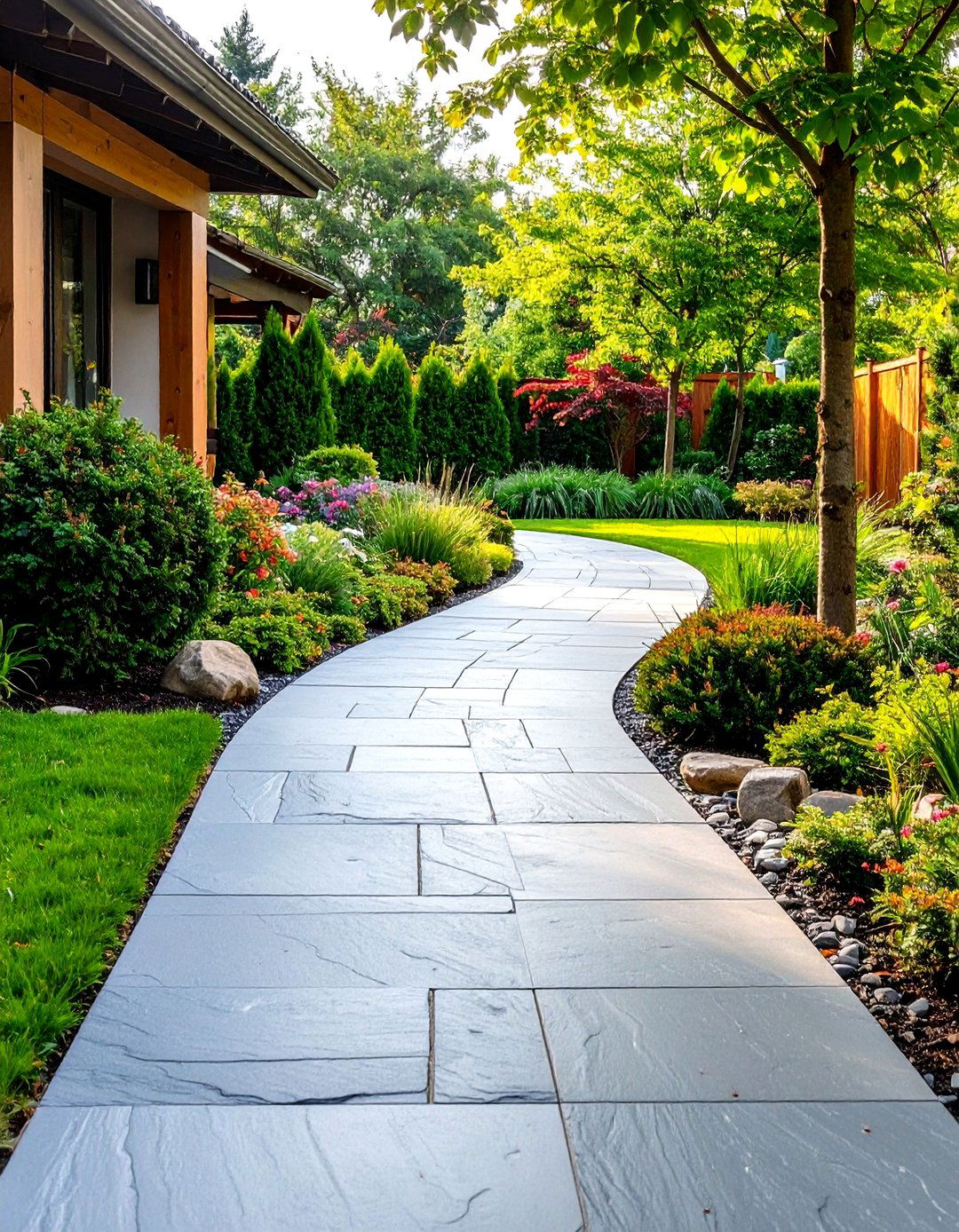
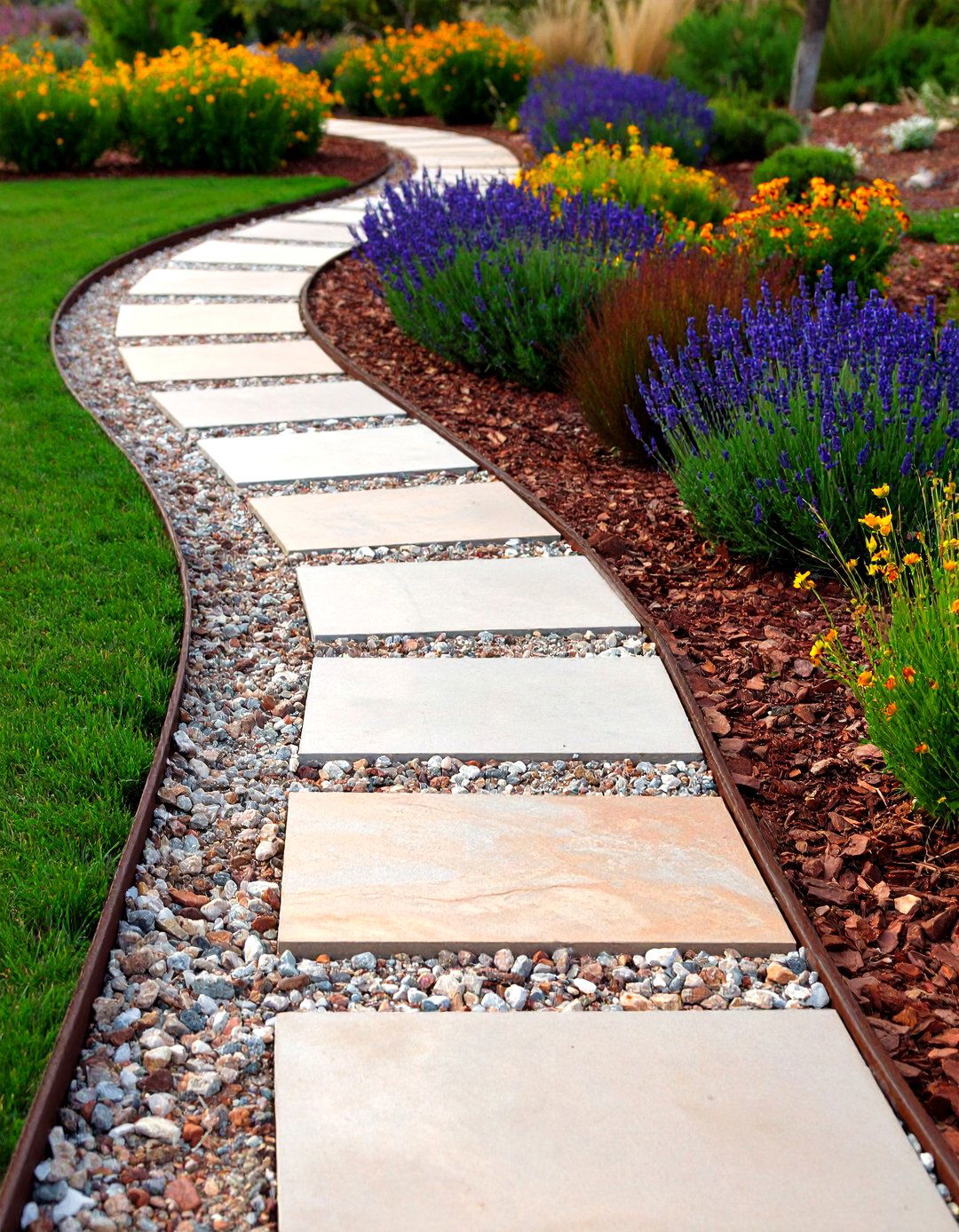
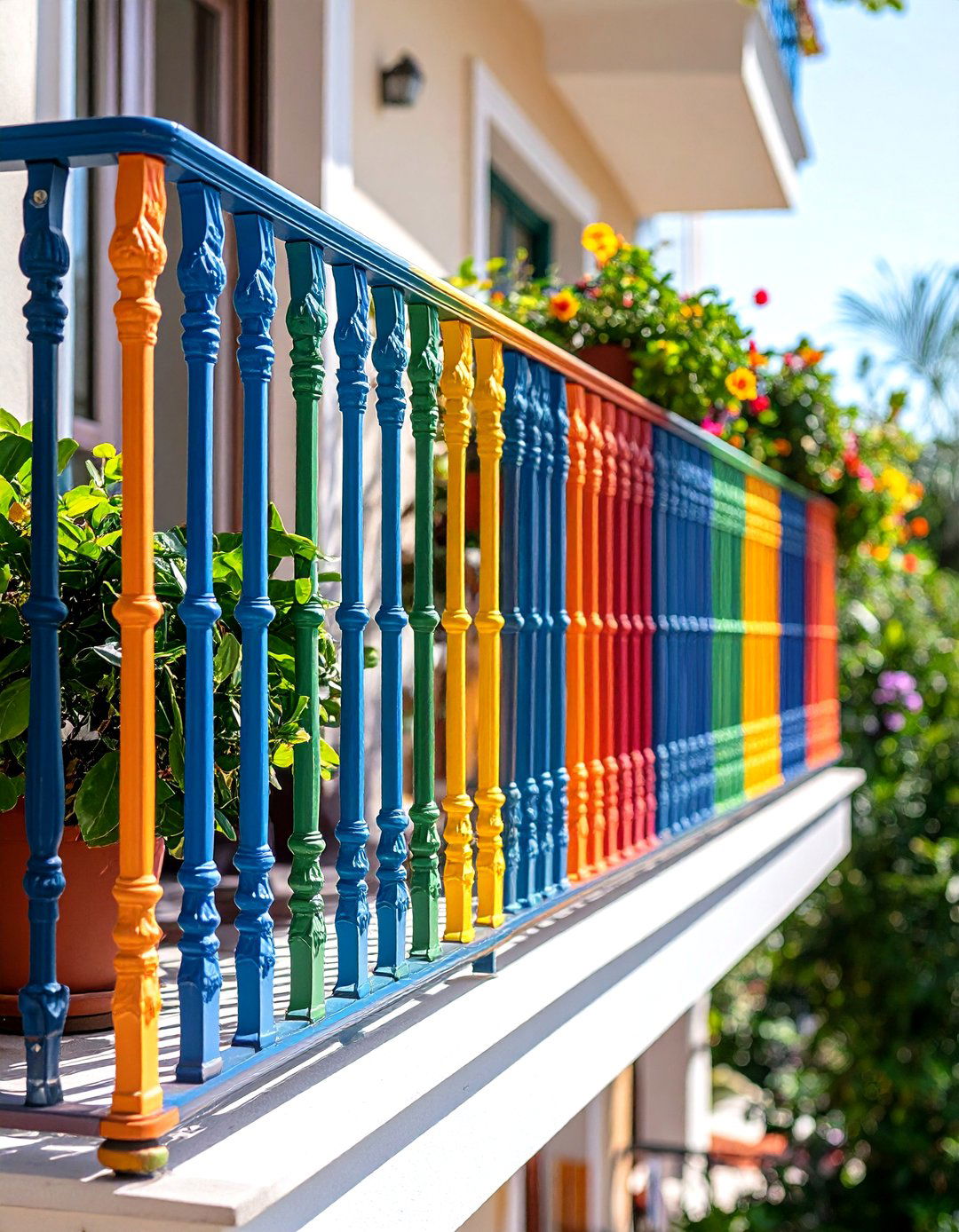
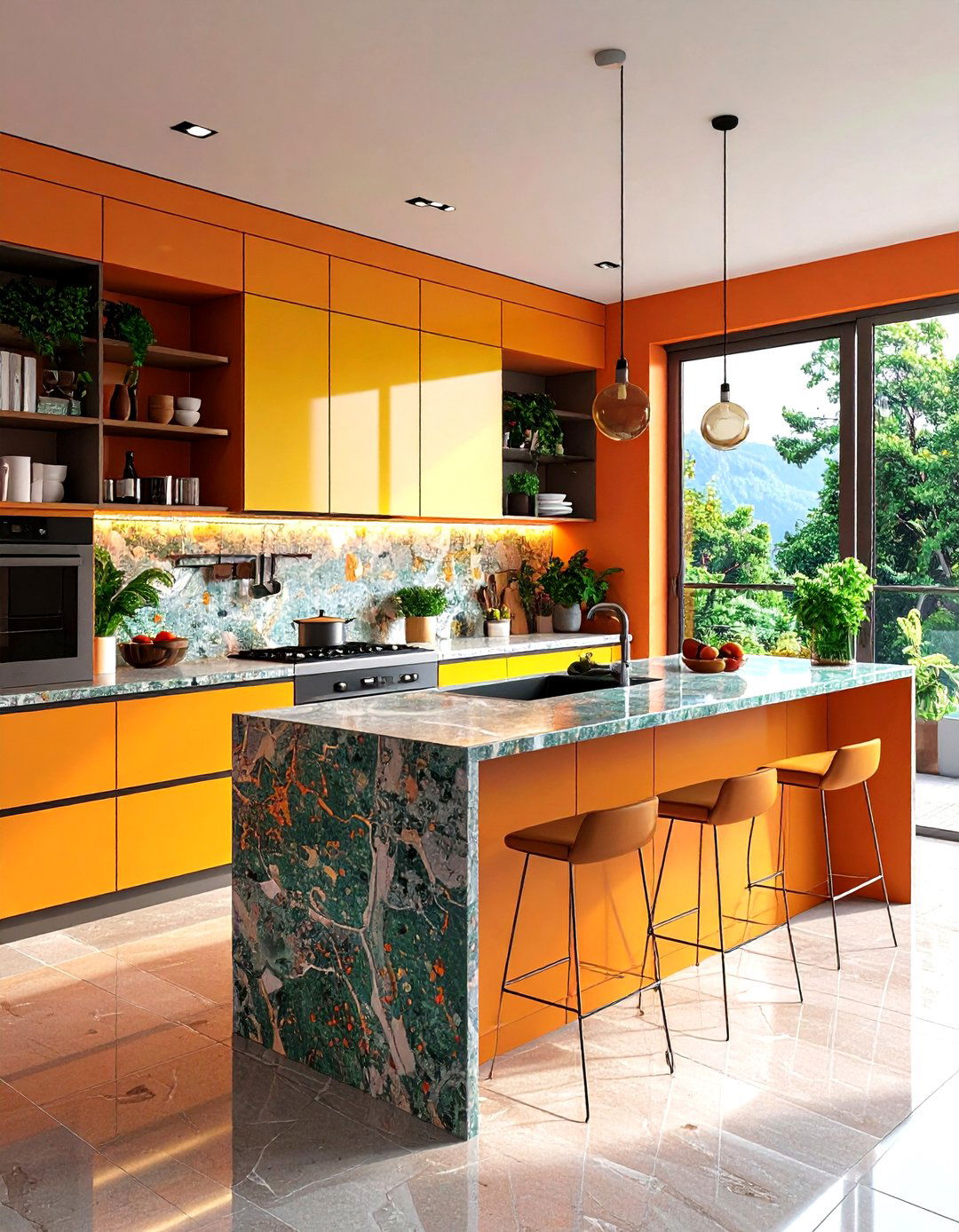


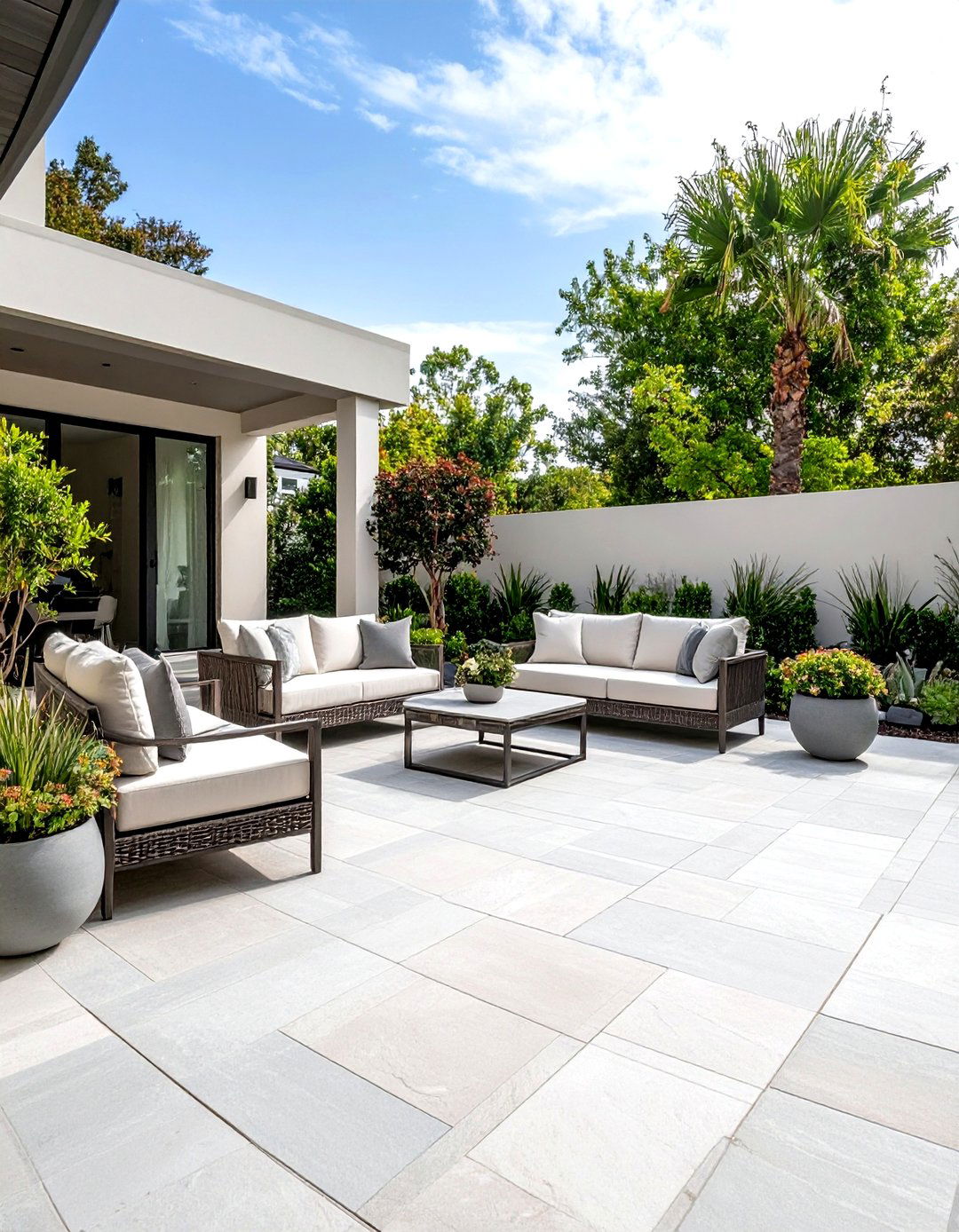
Leave a Reply